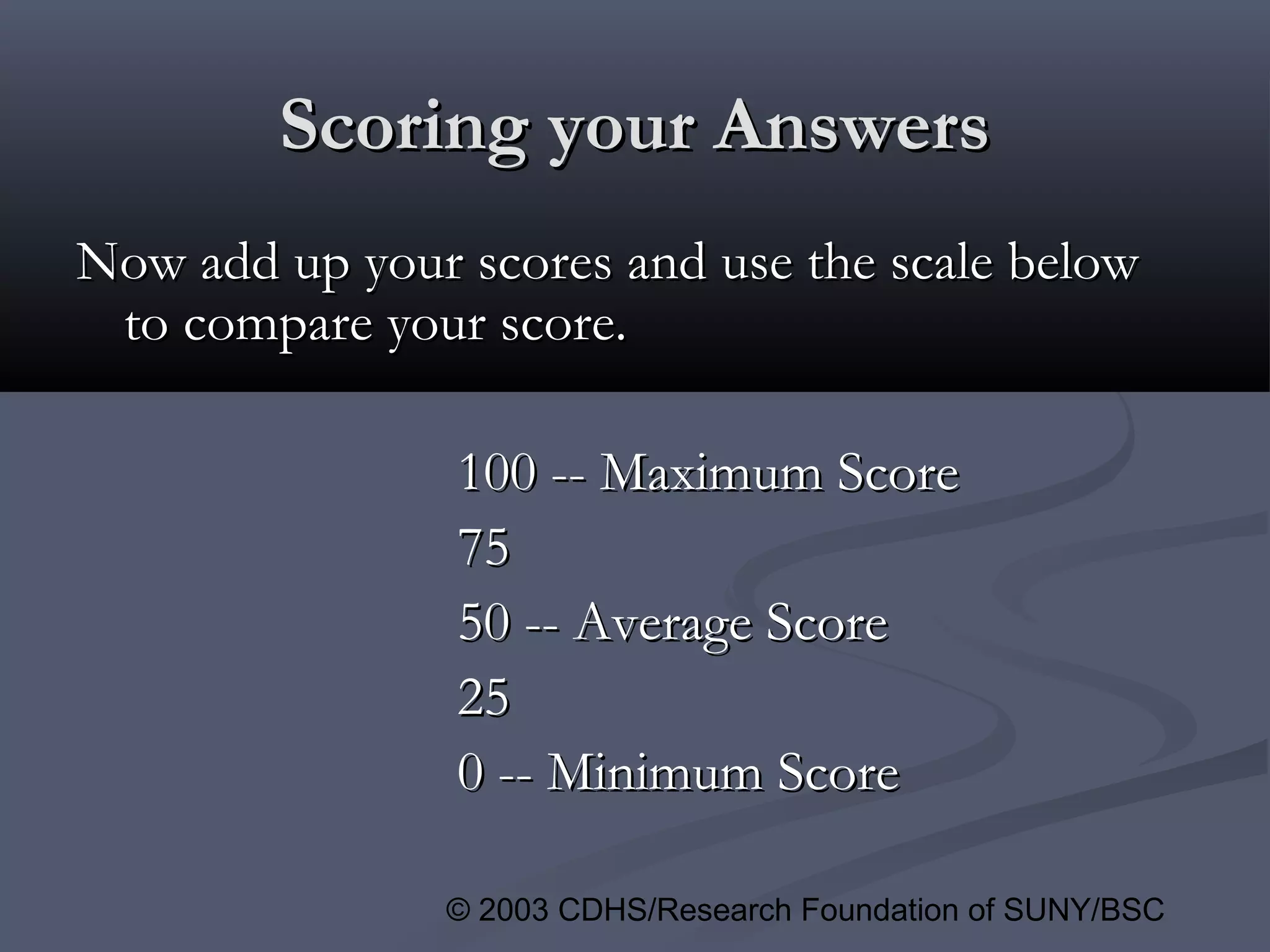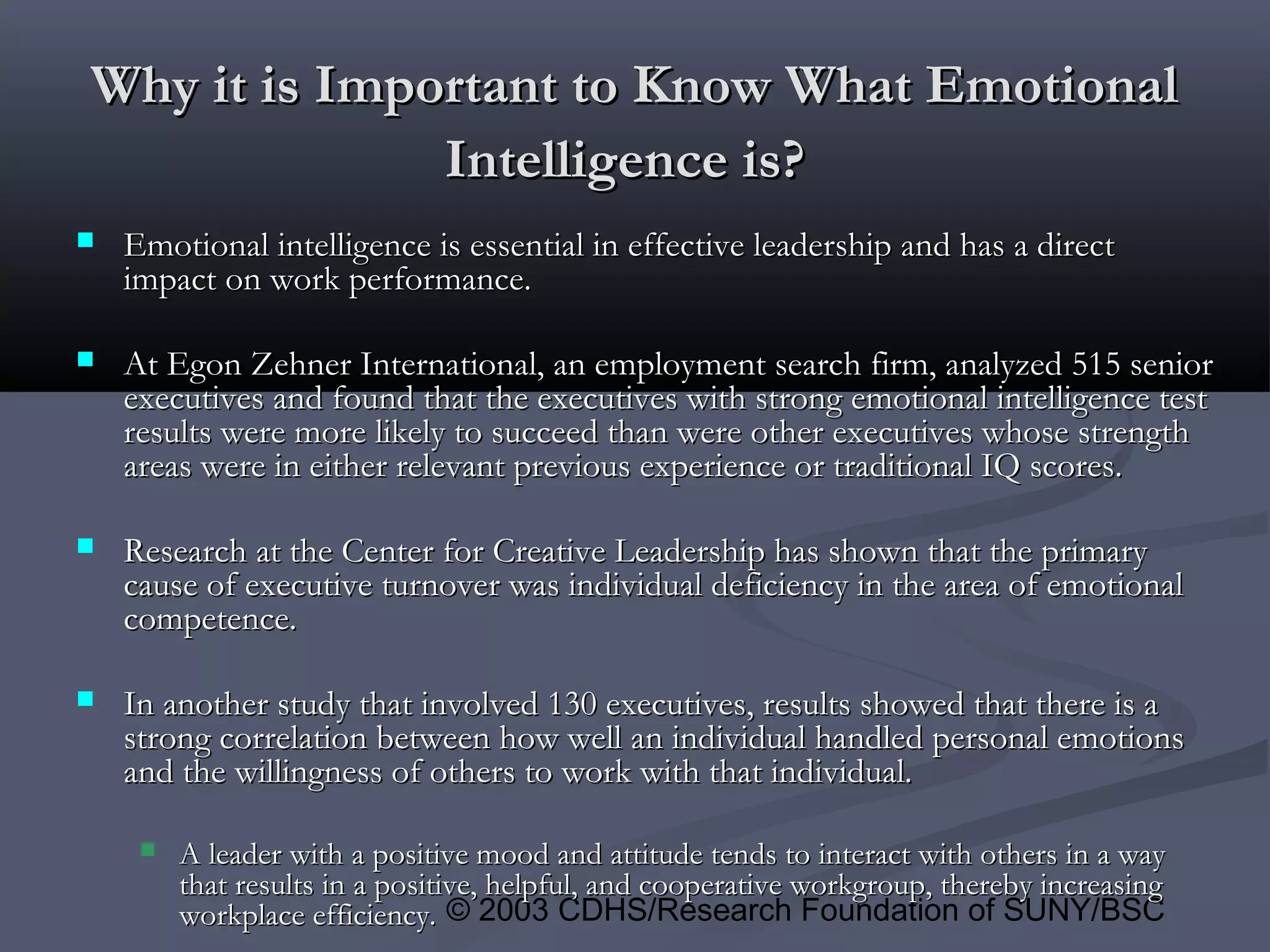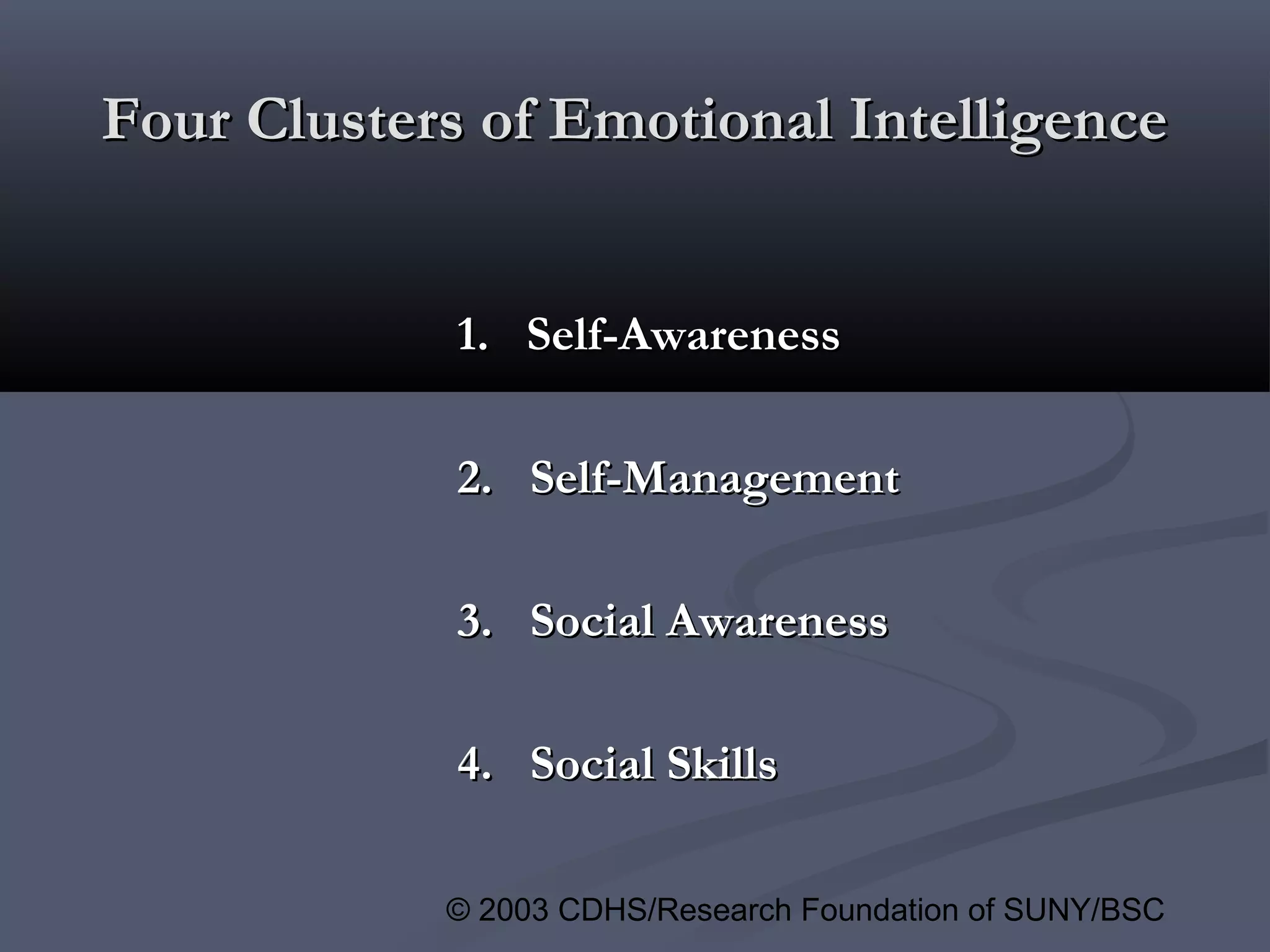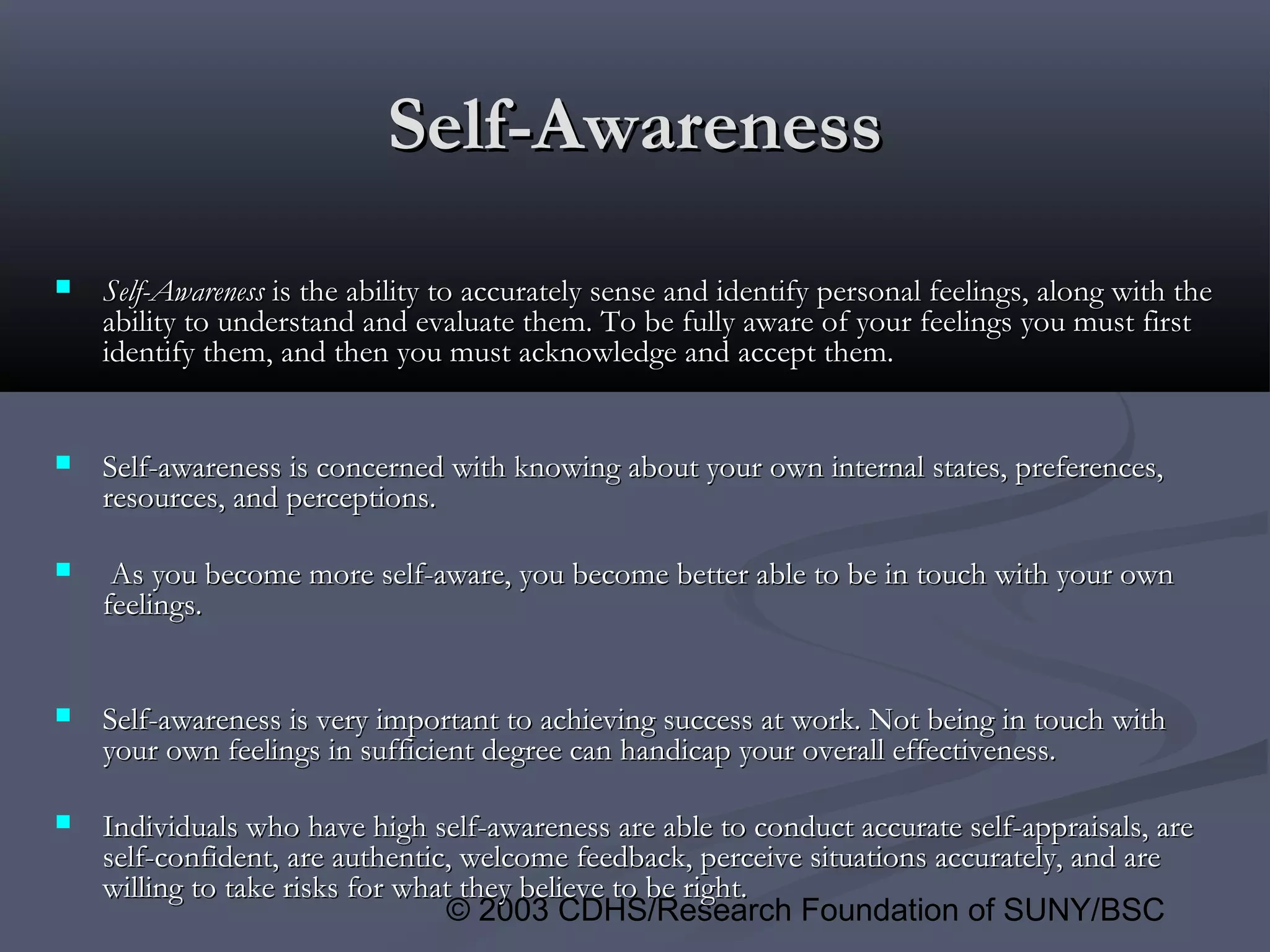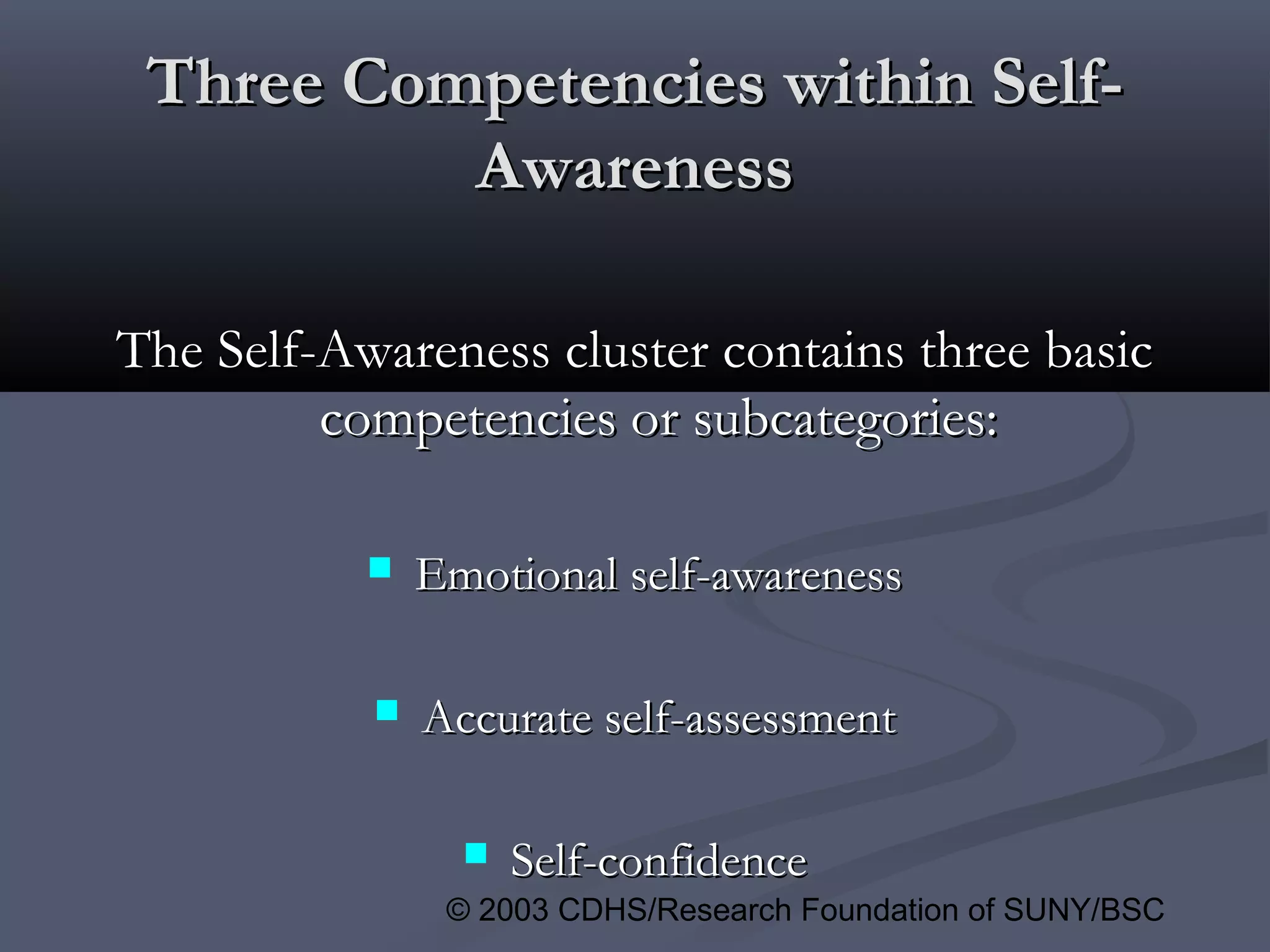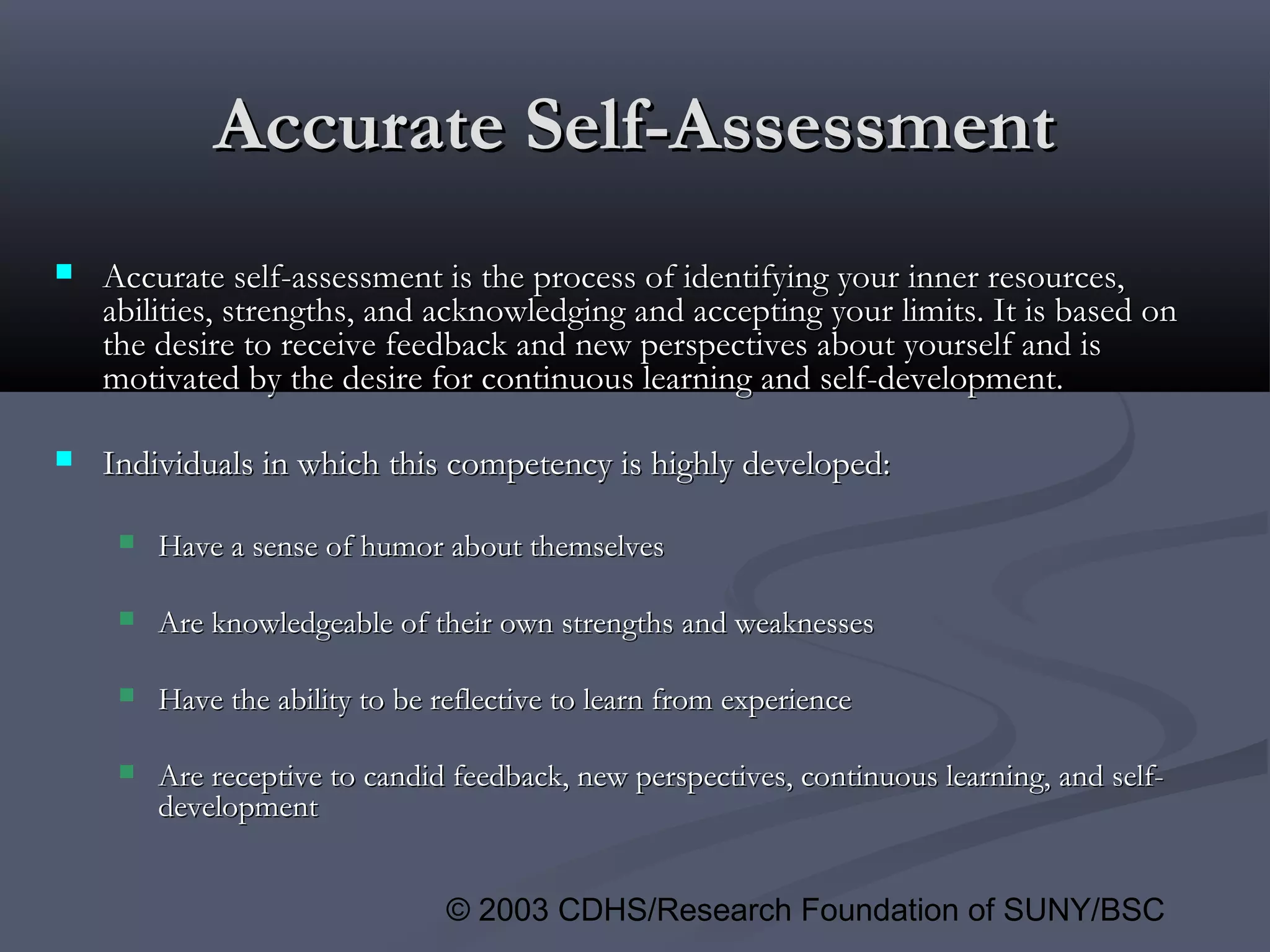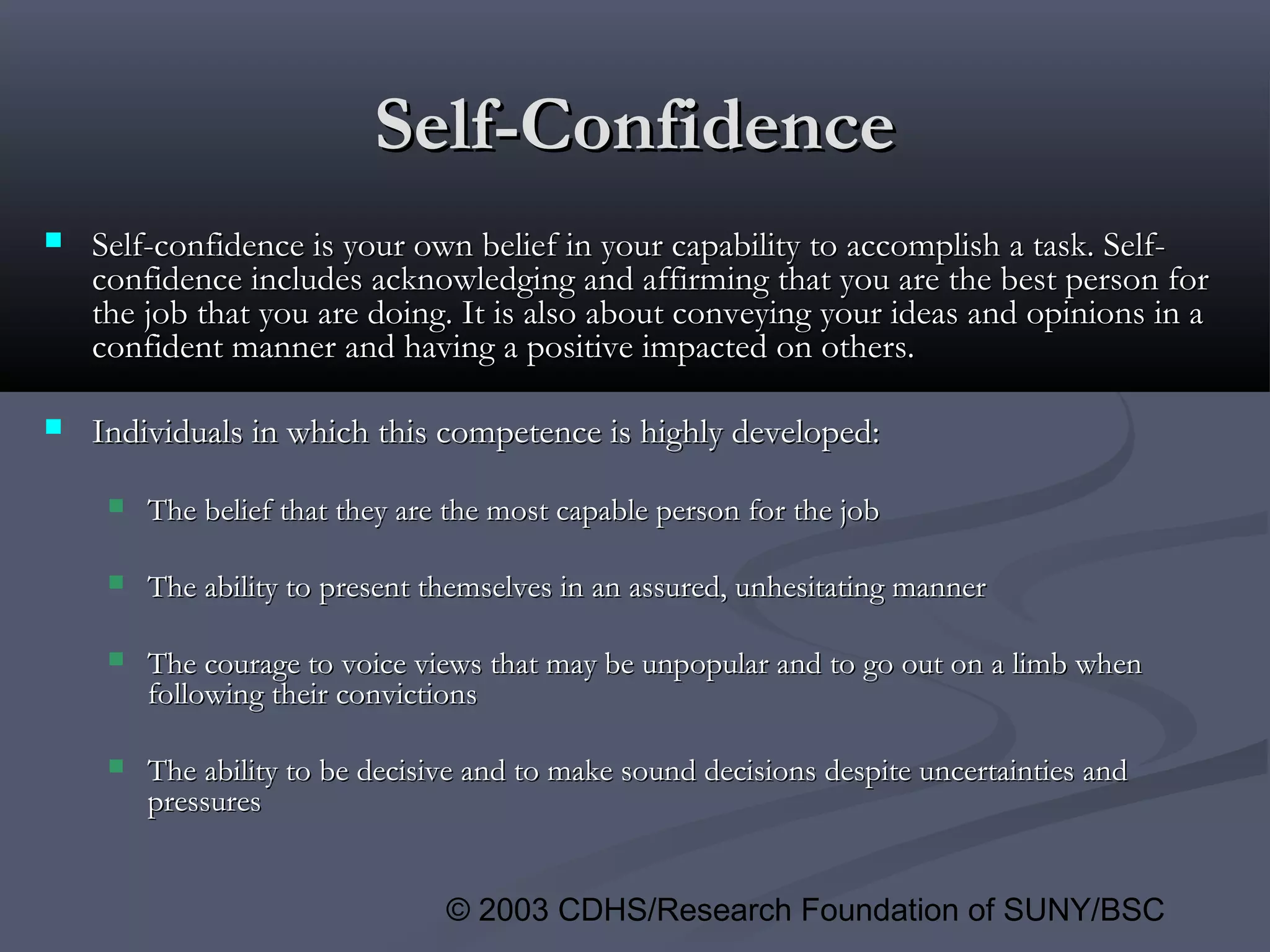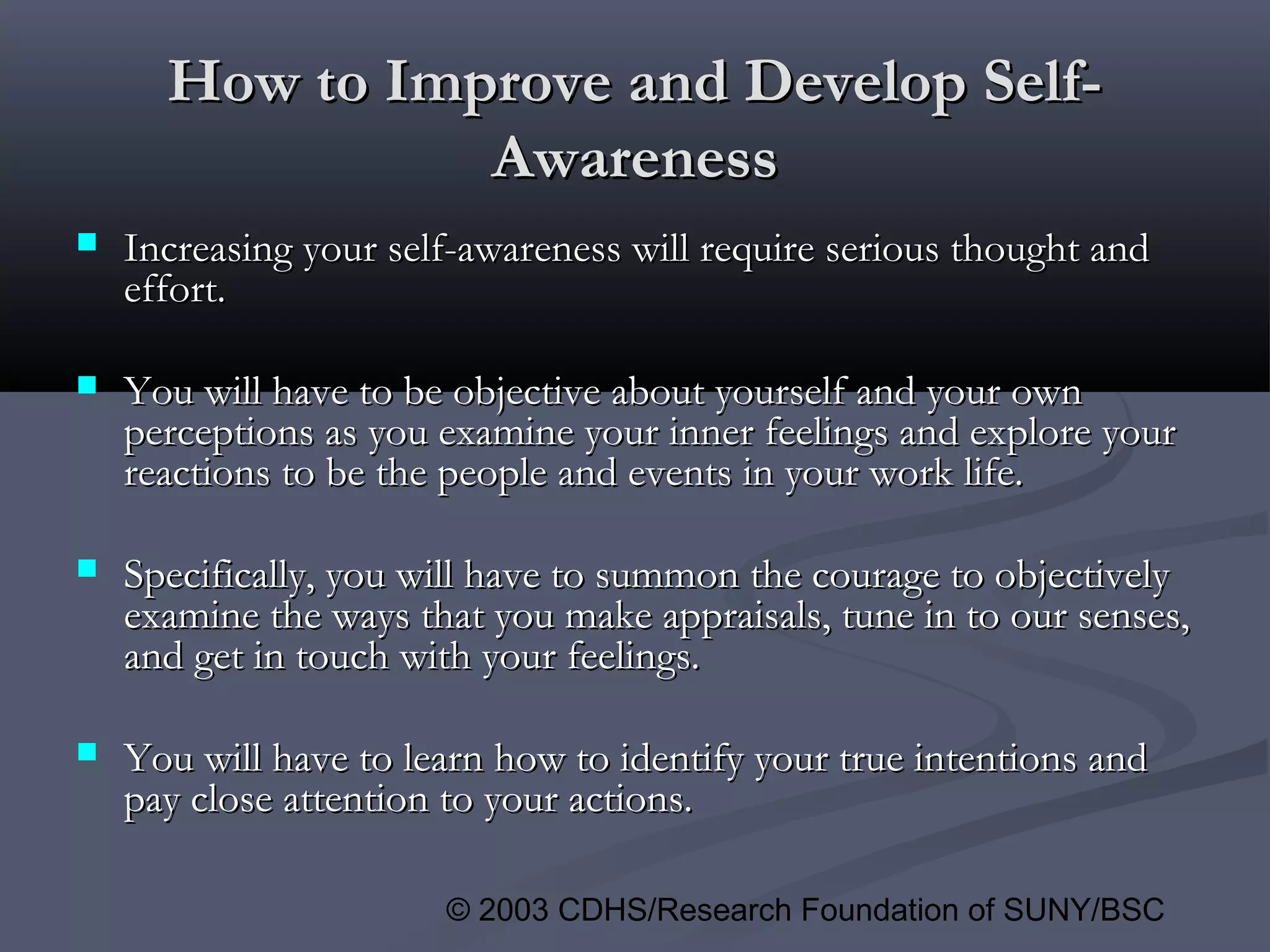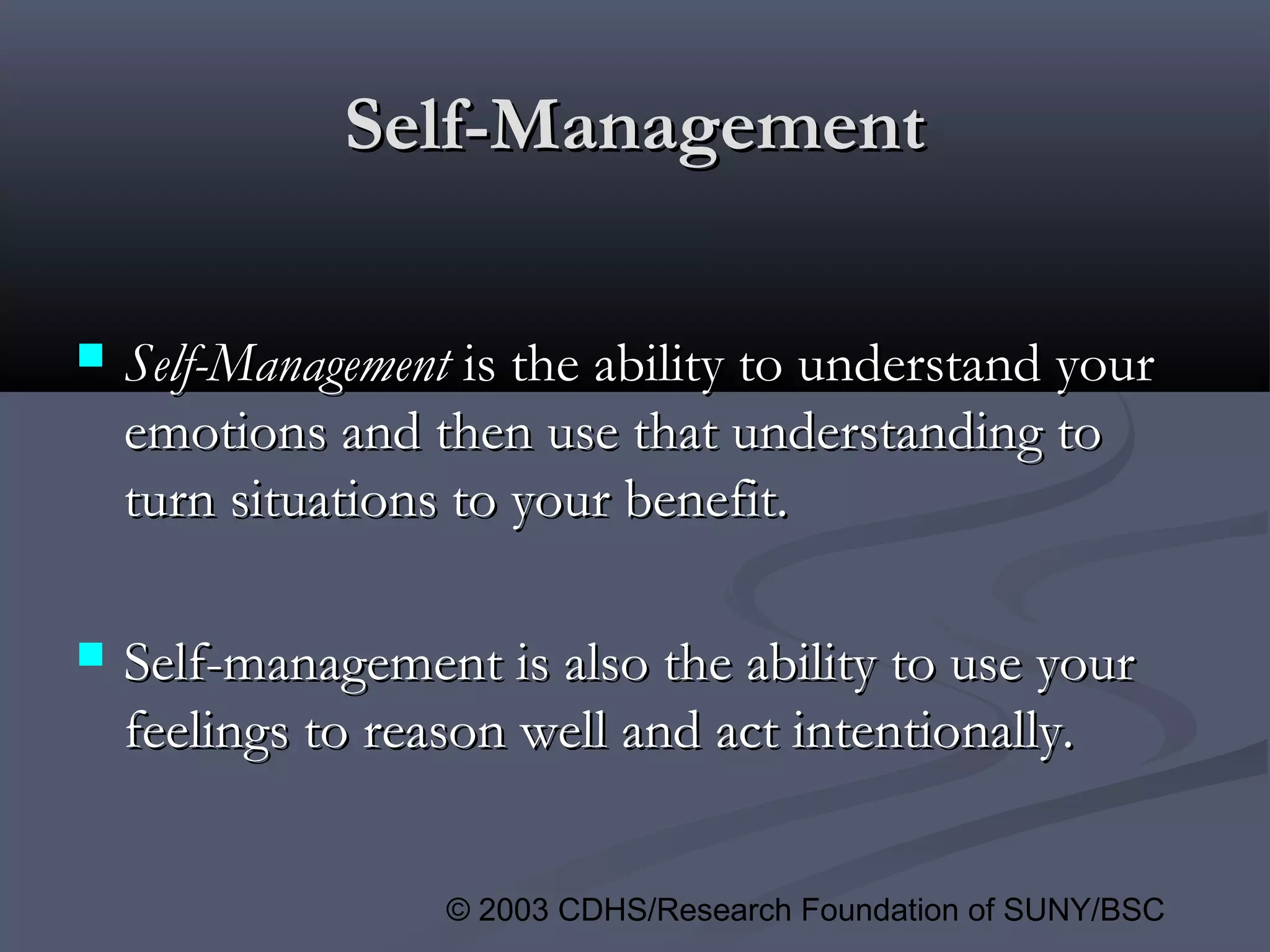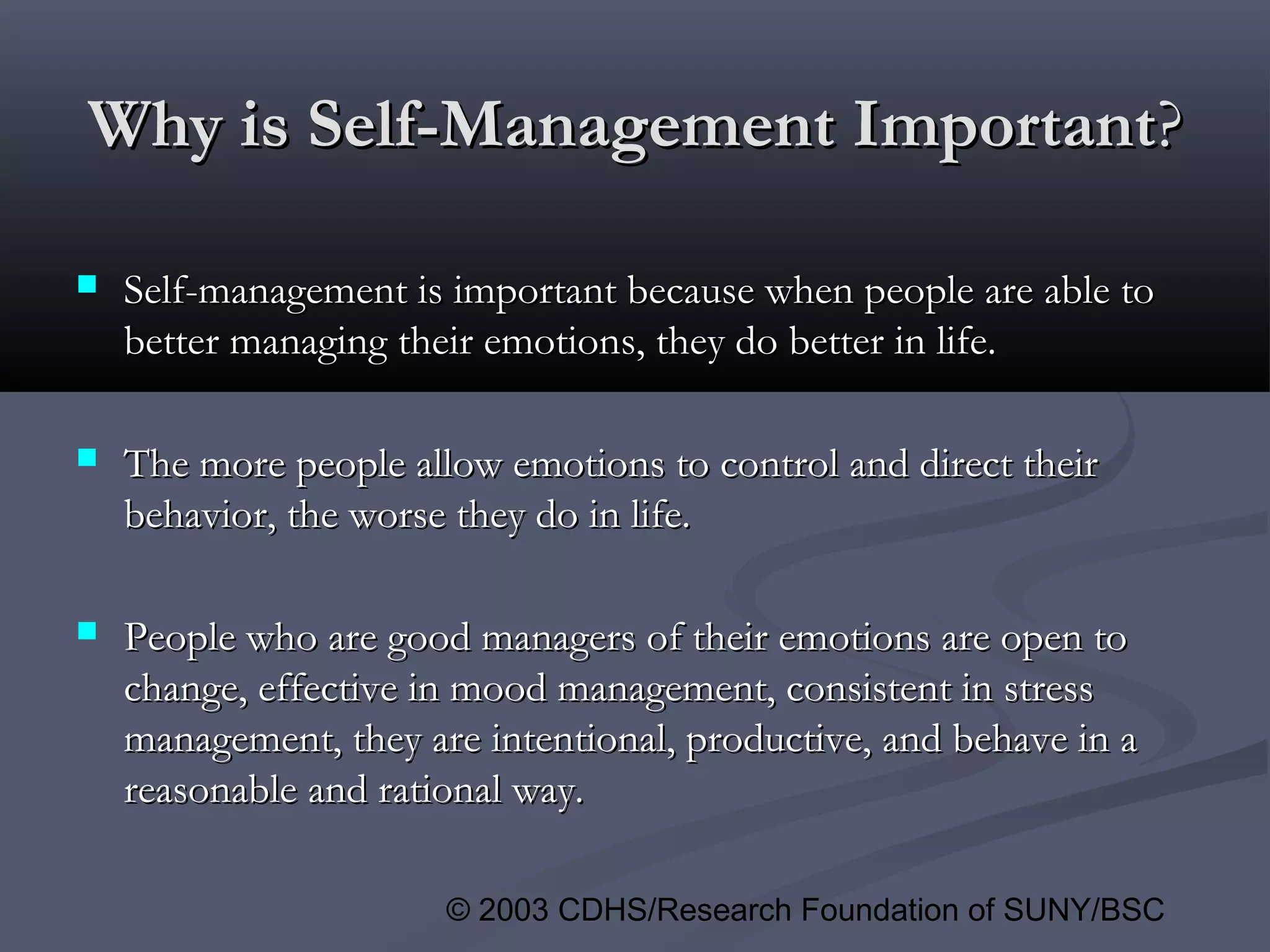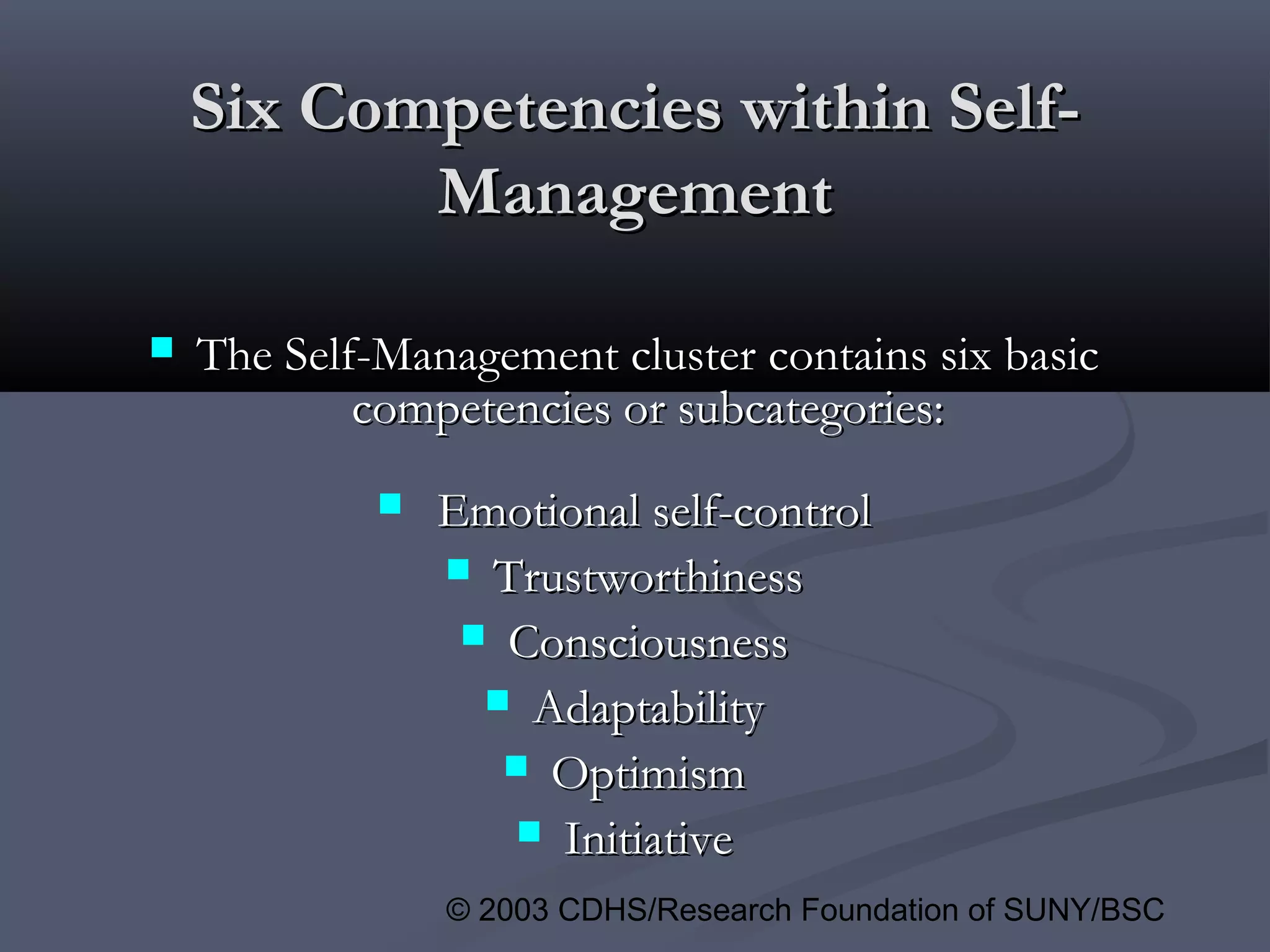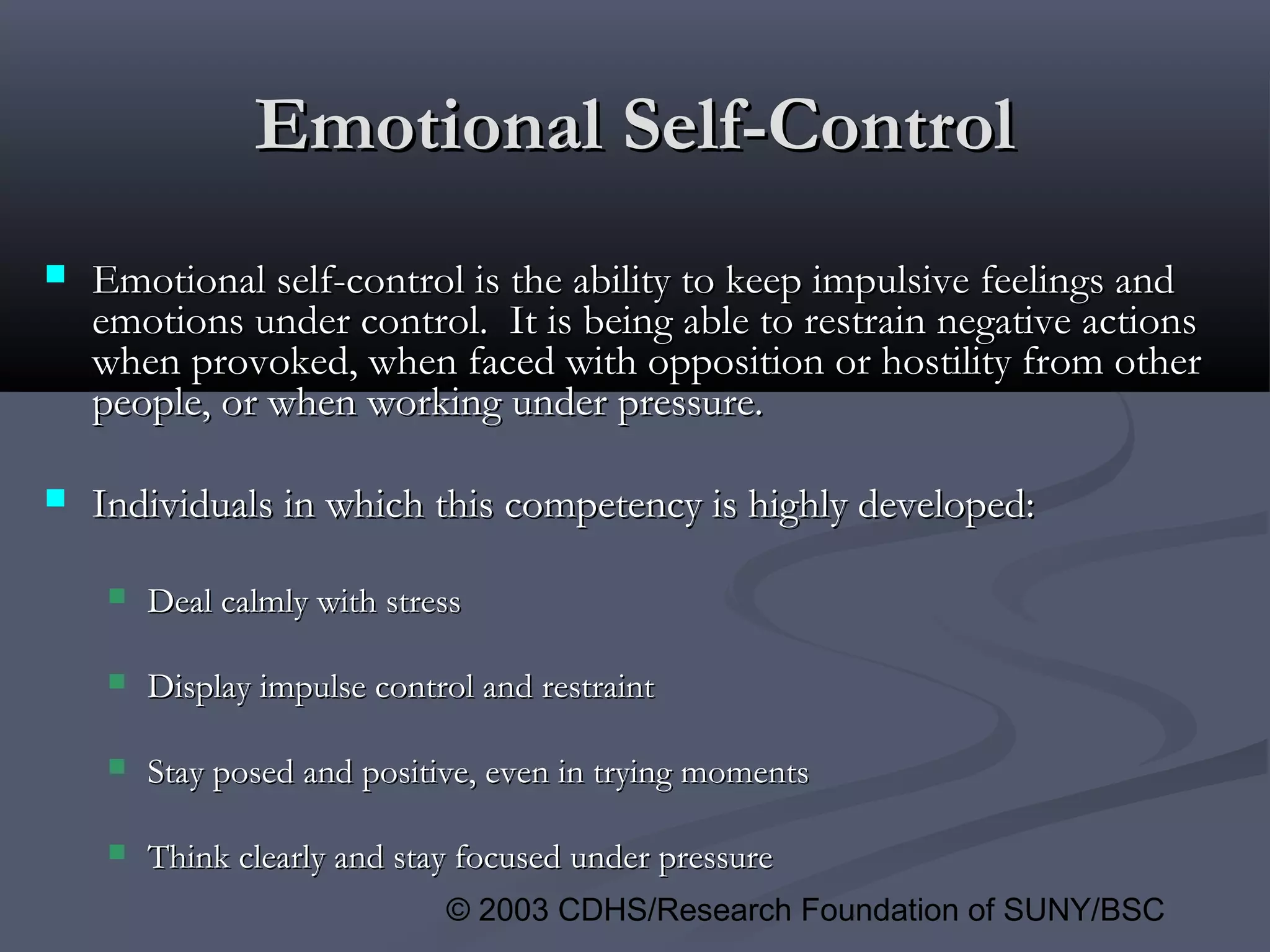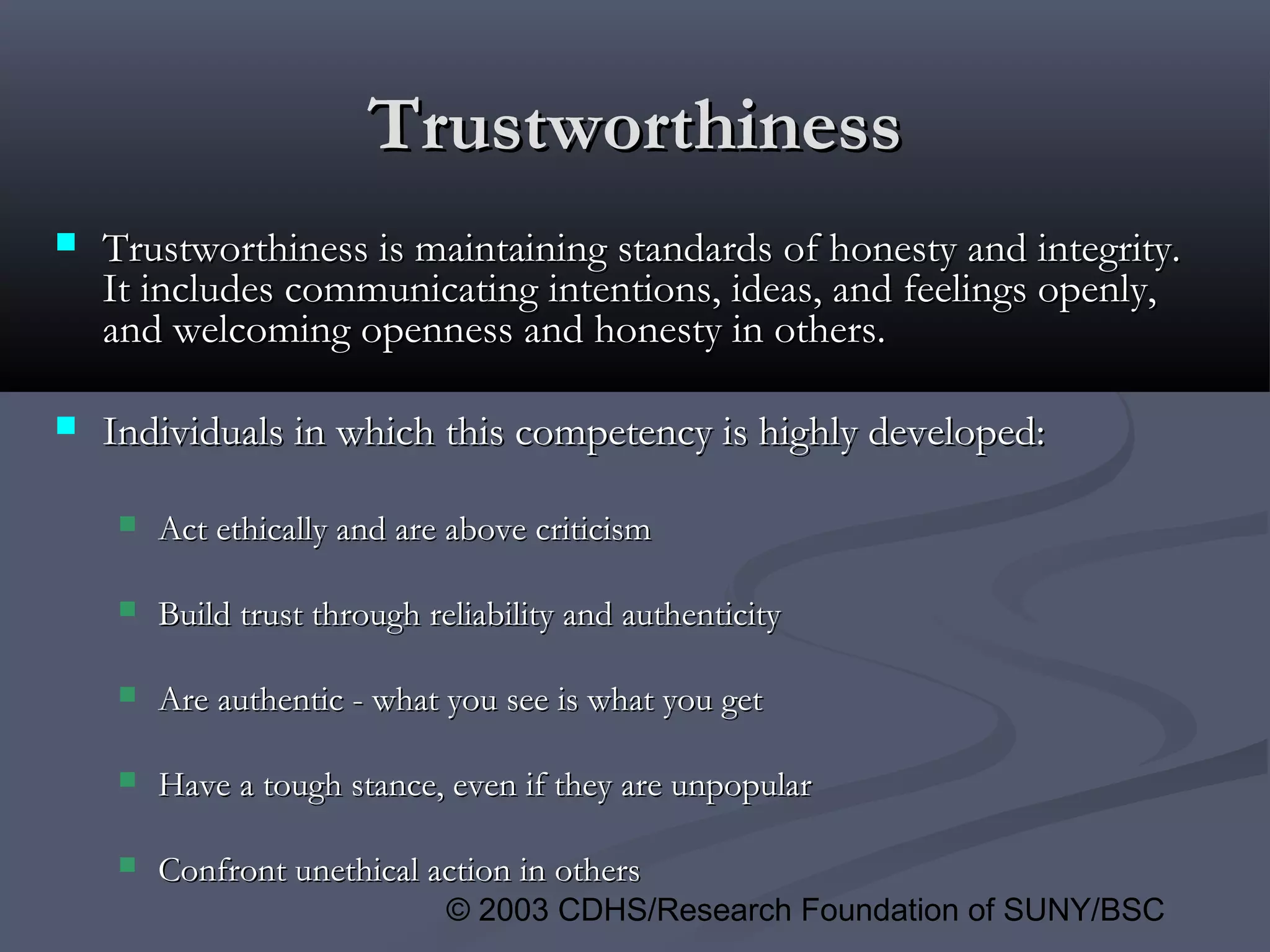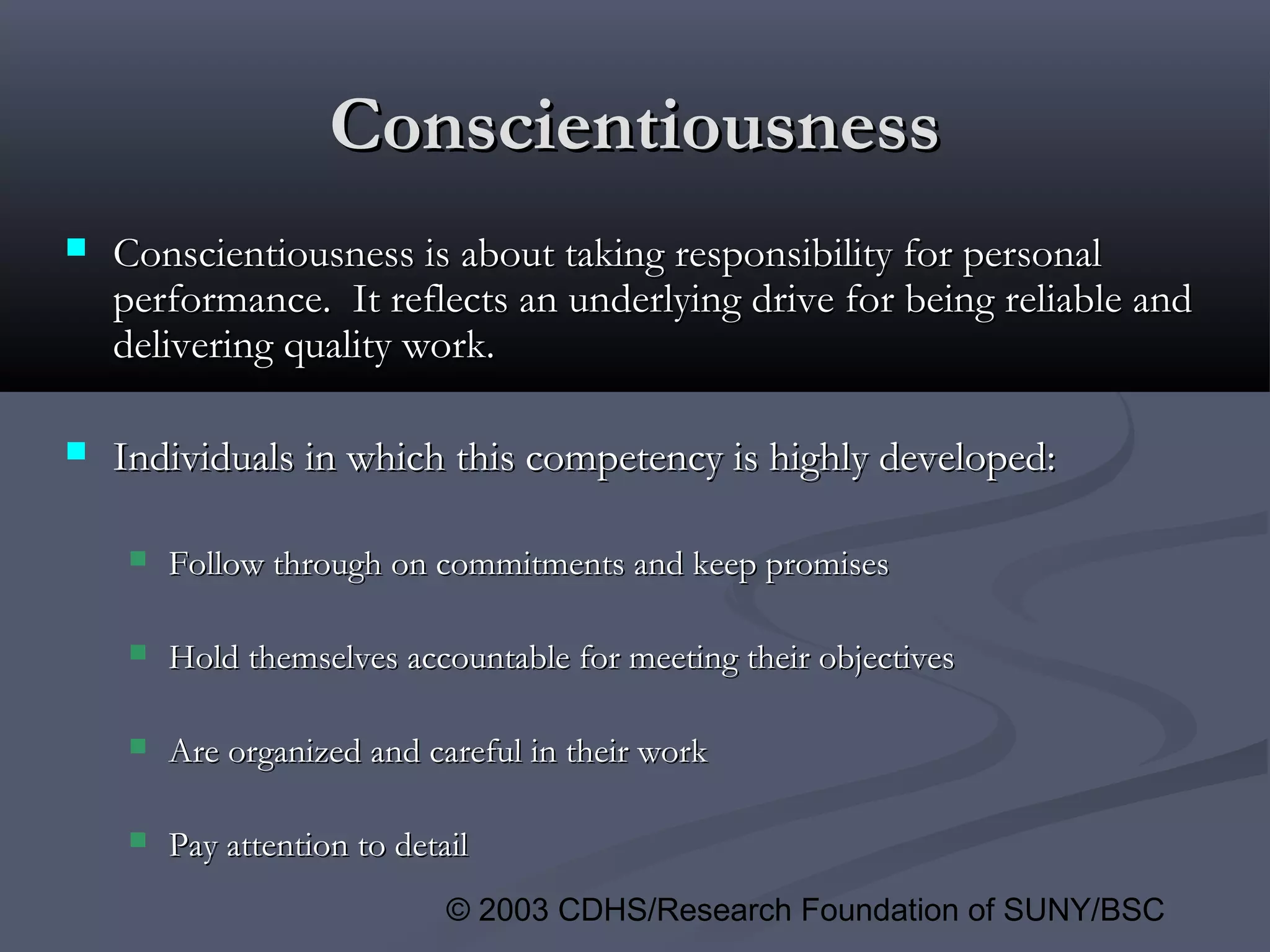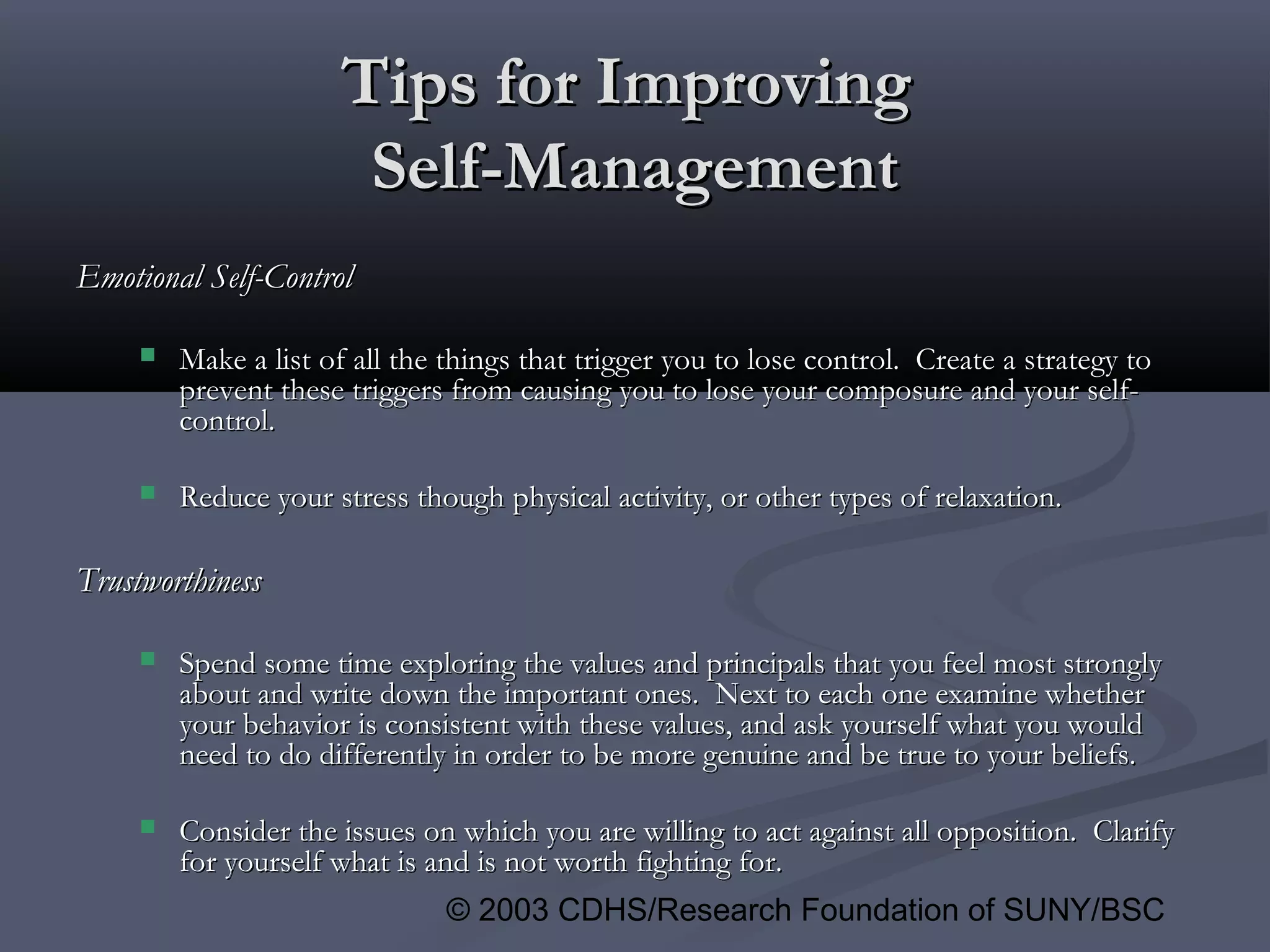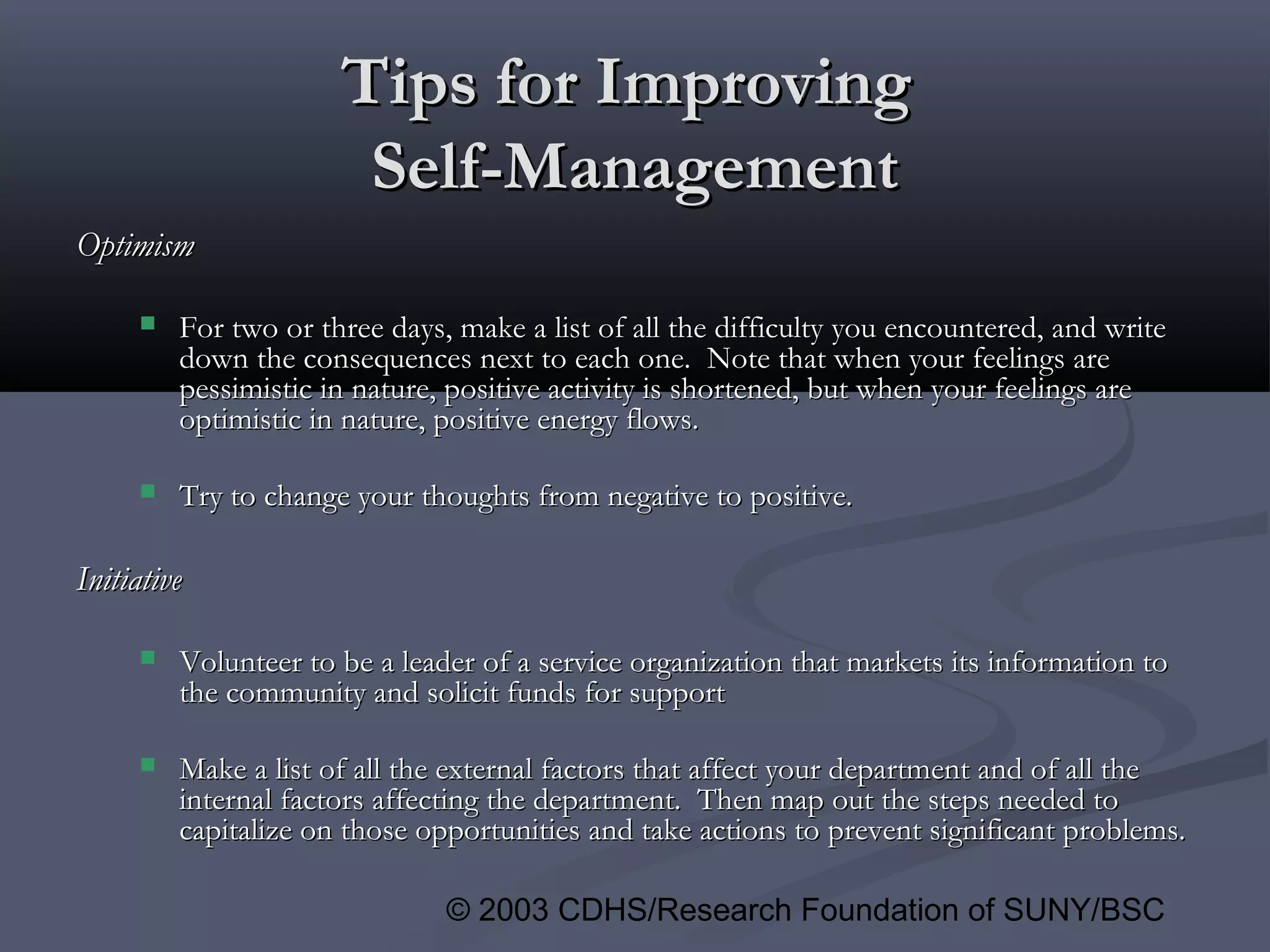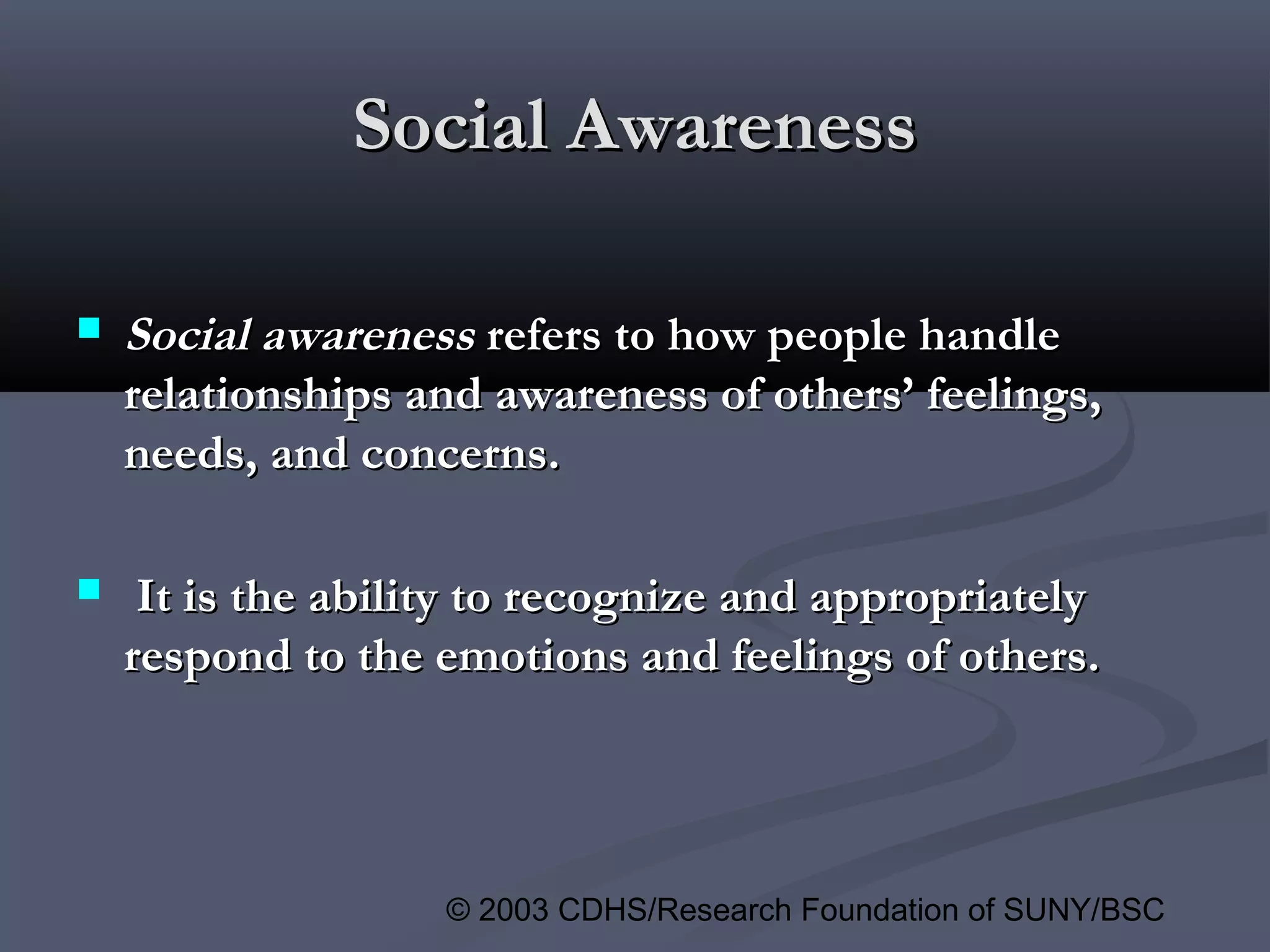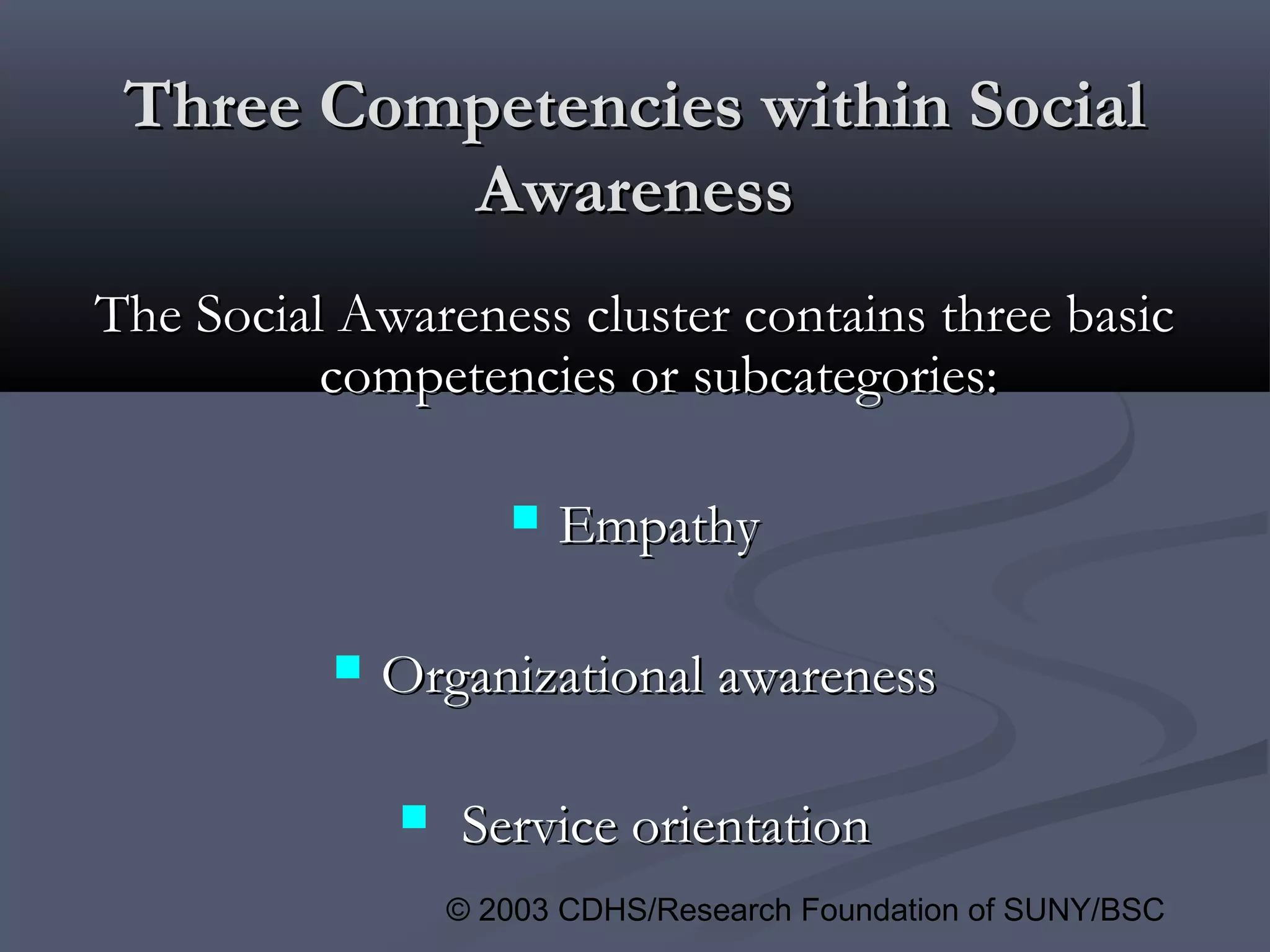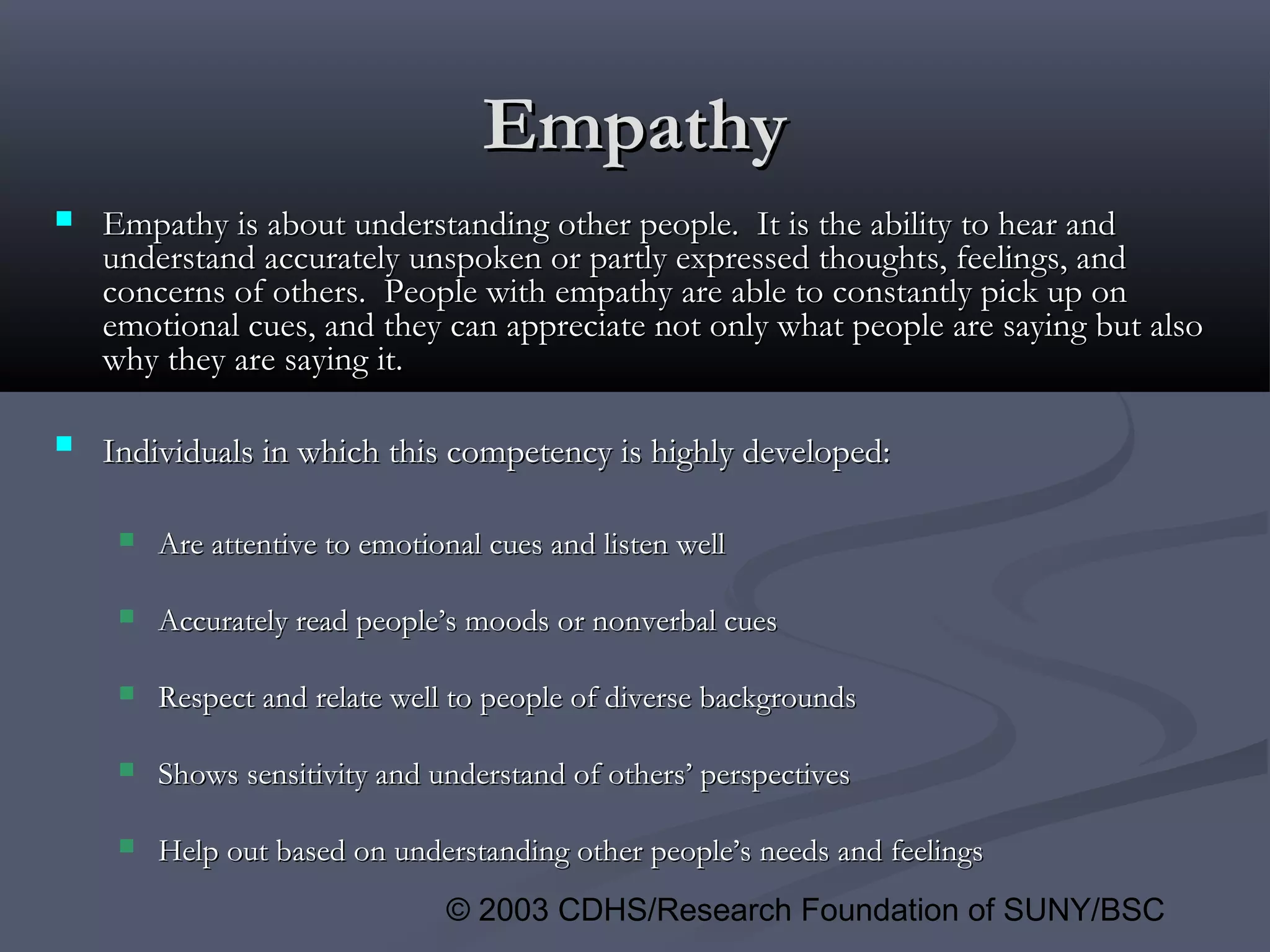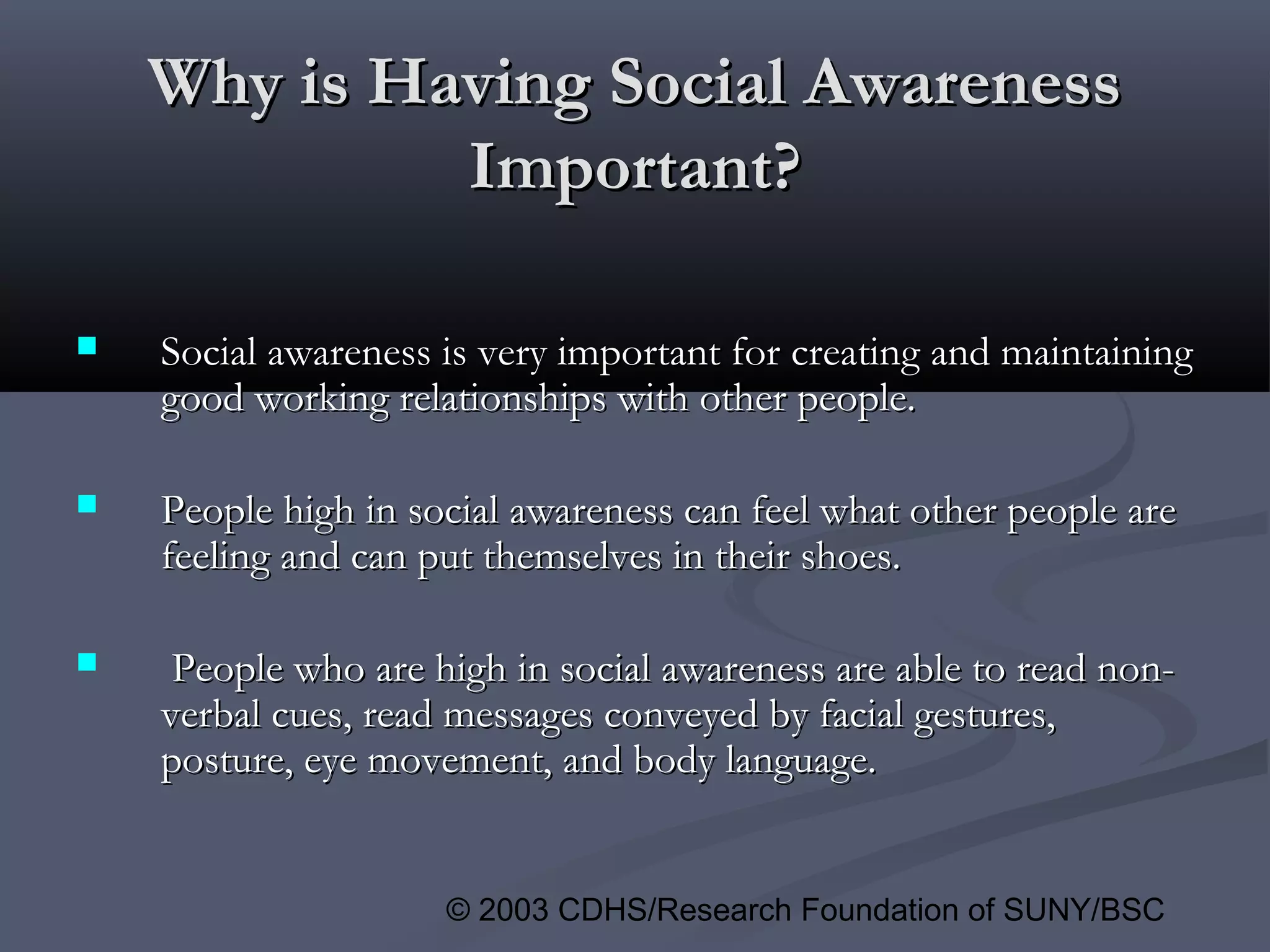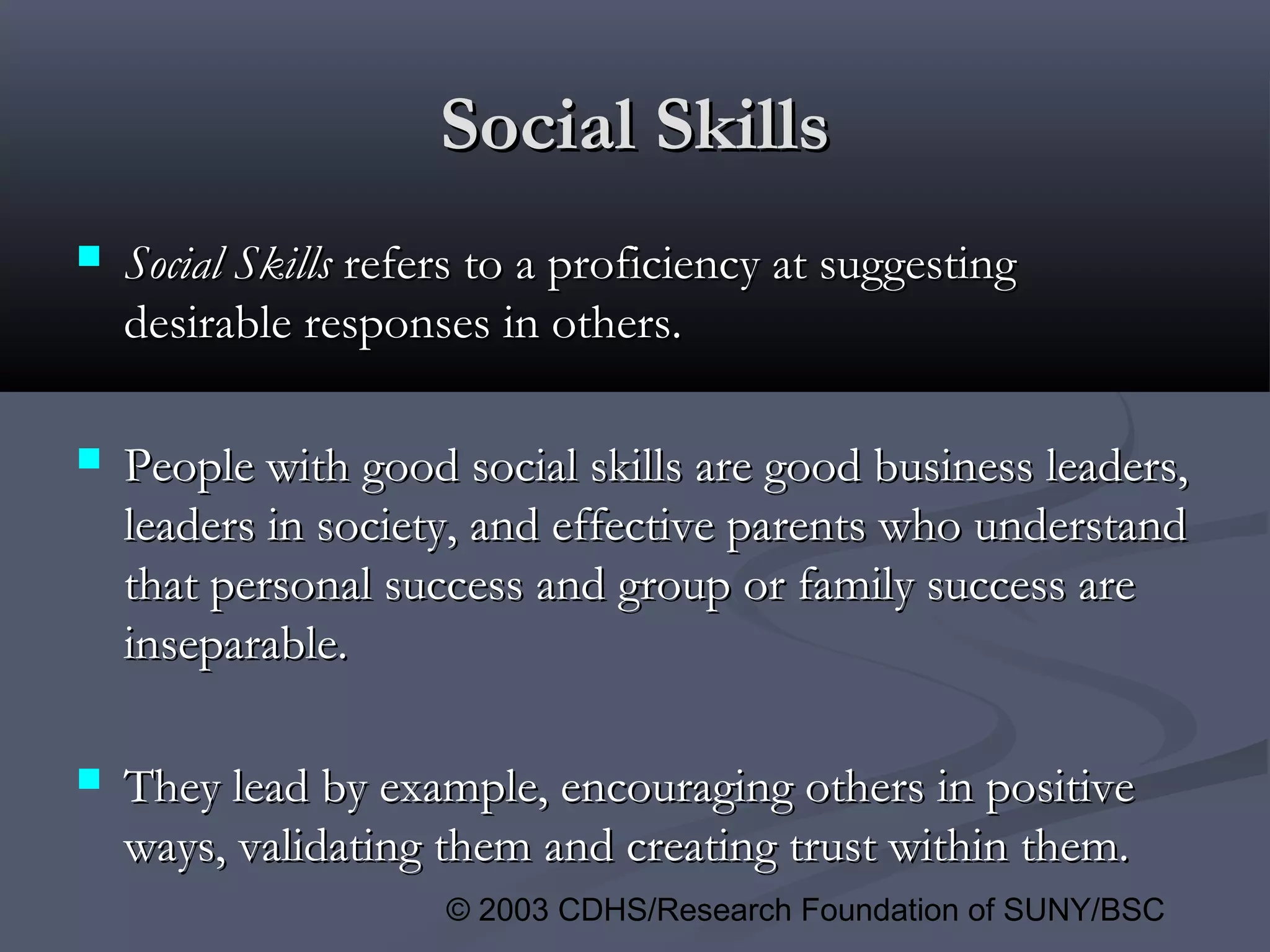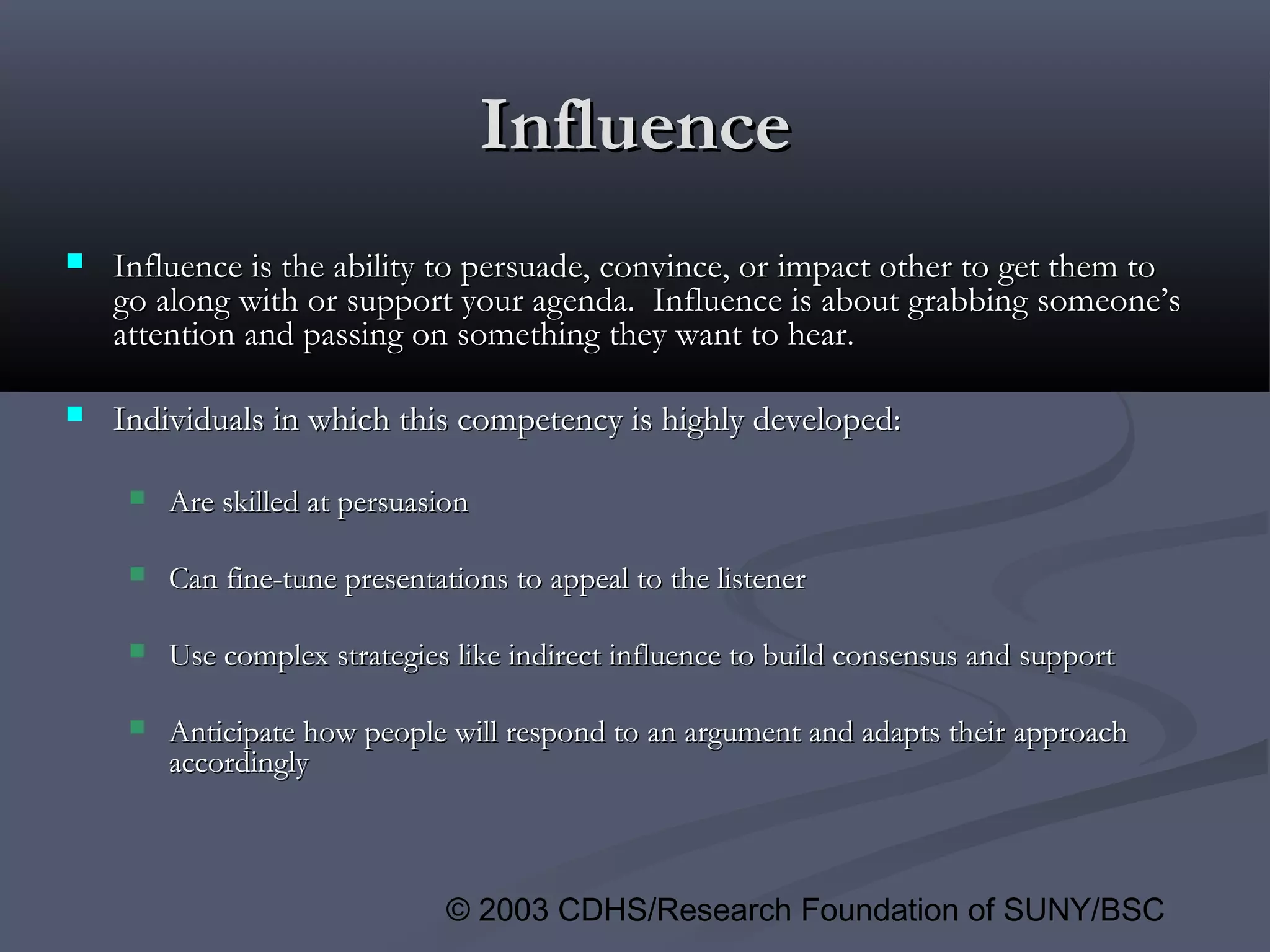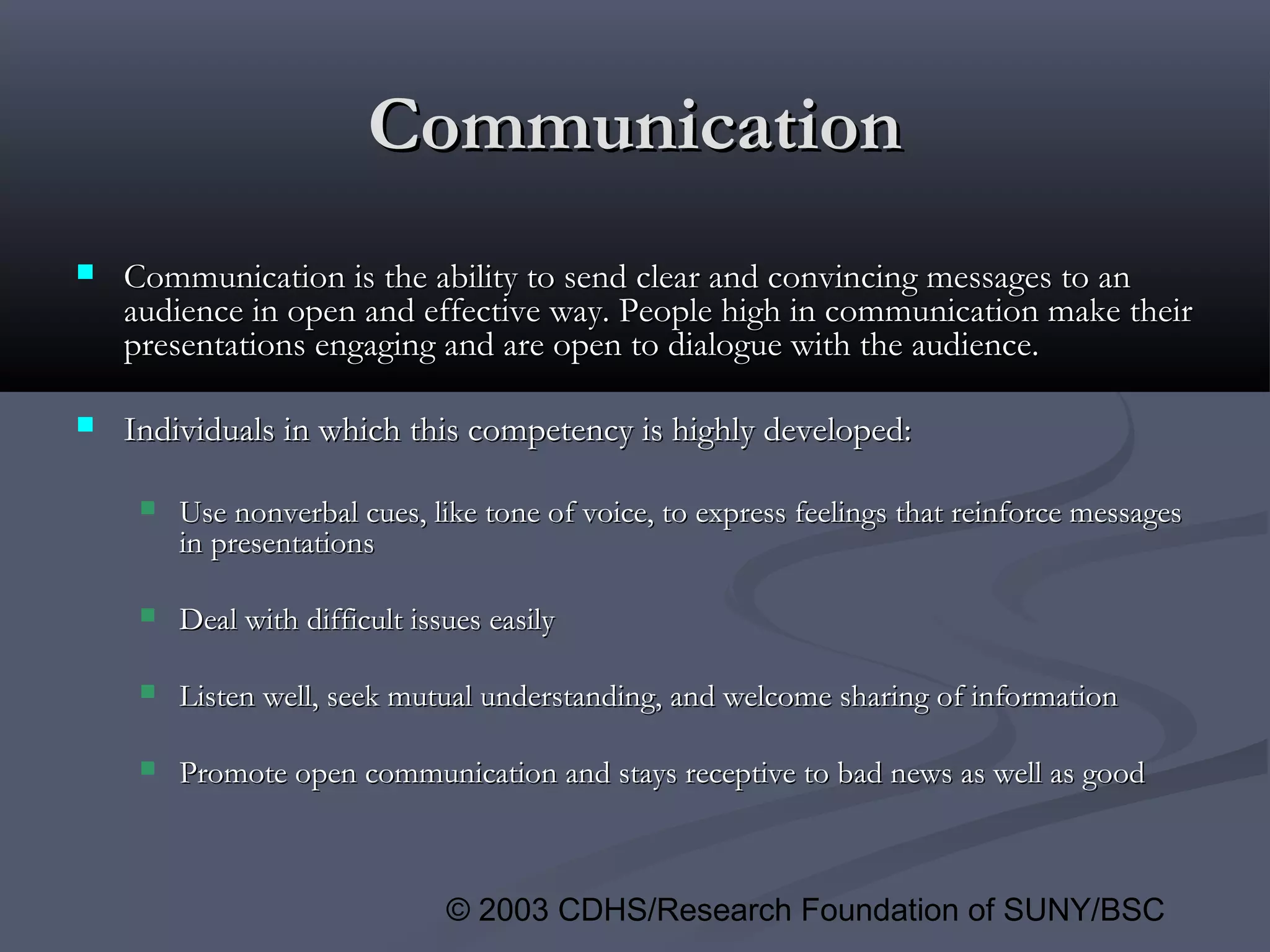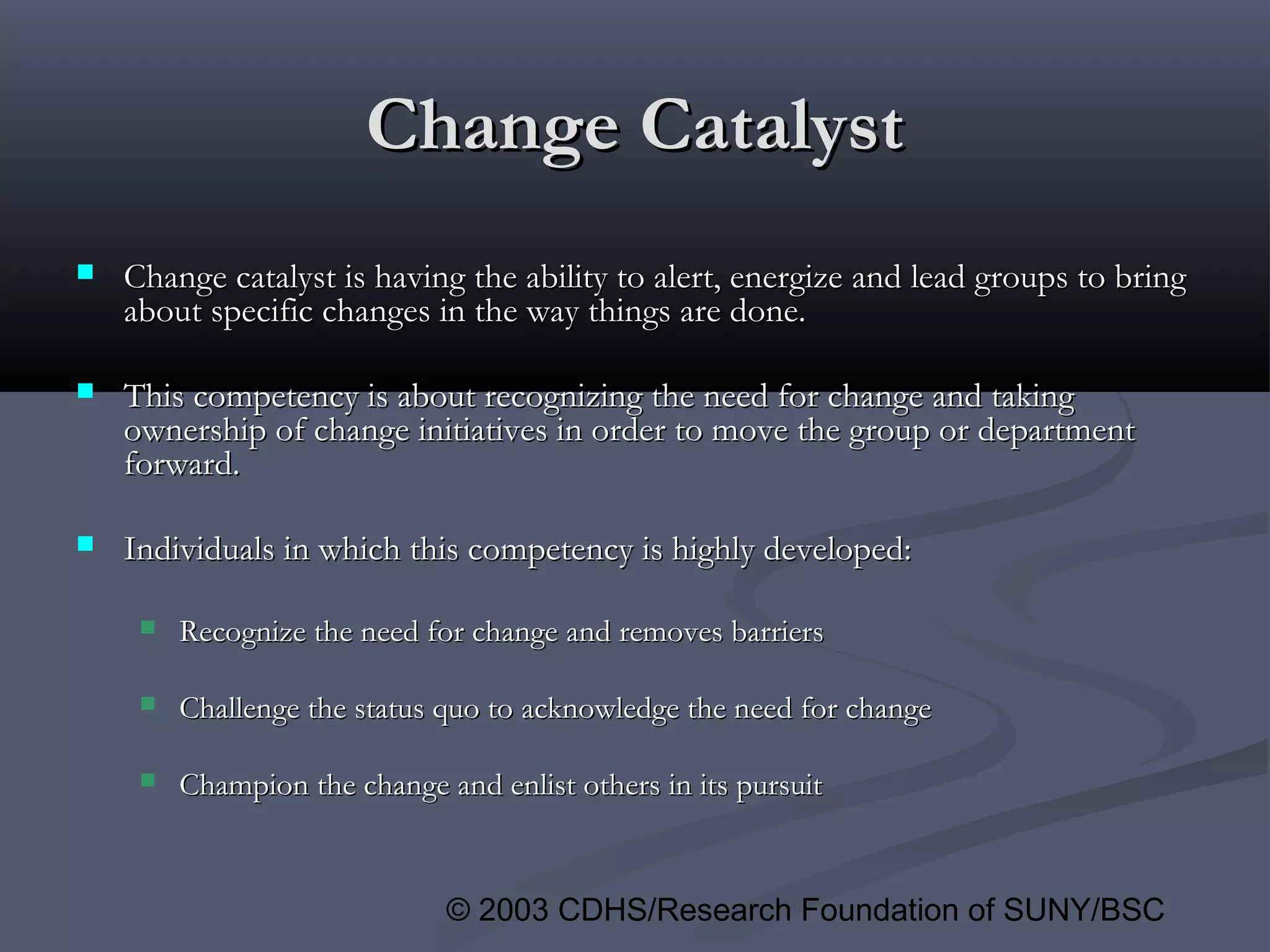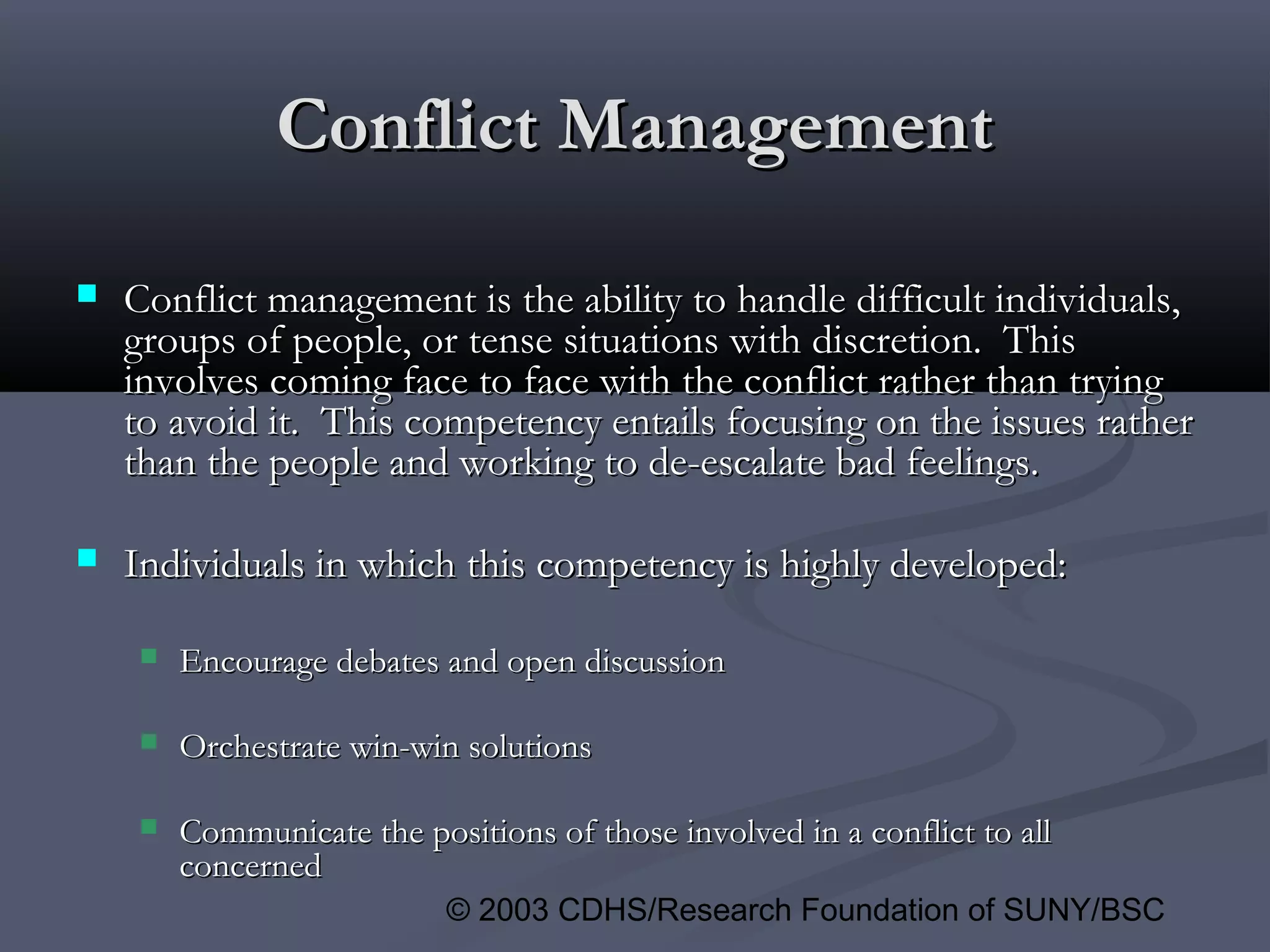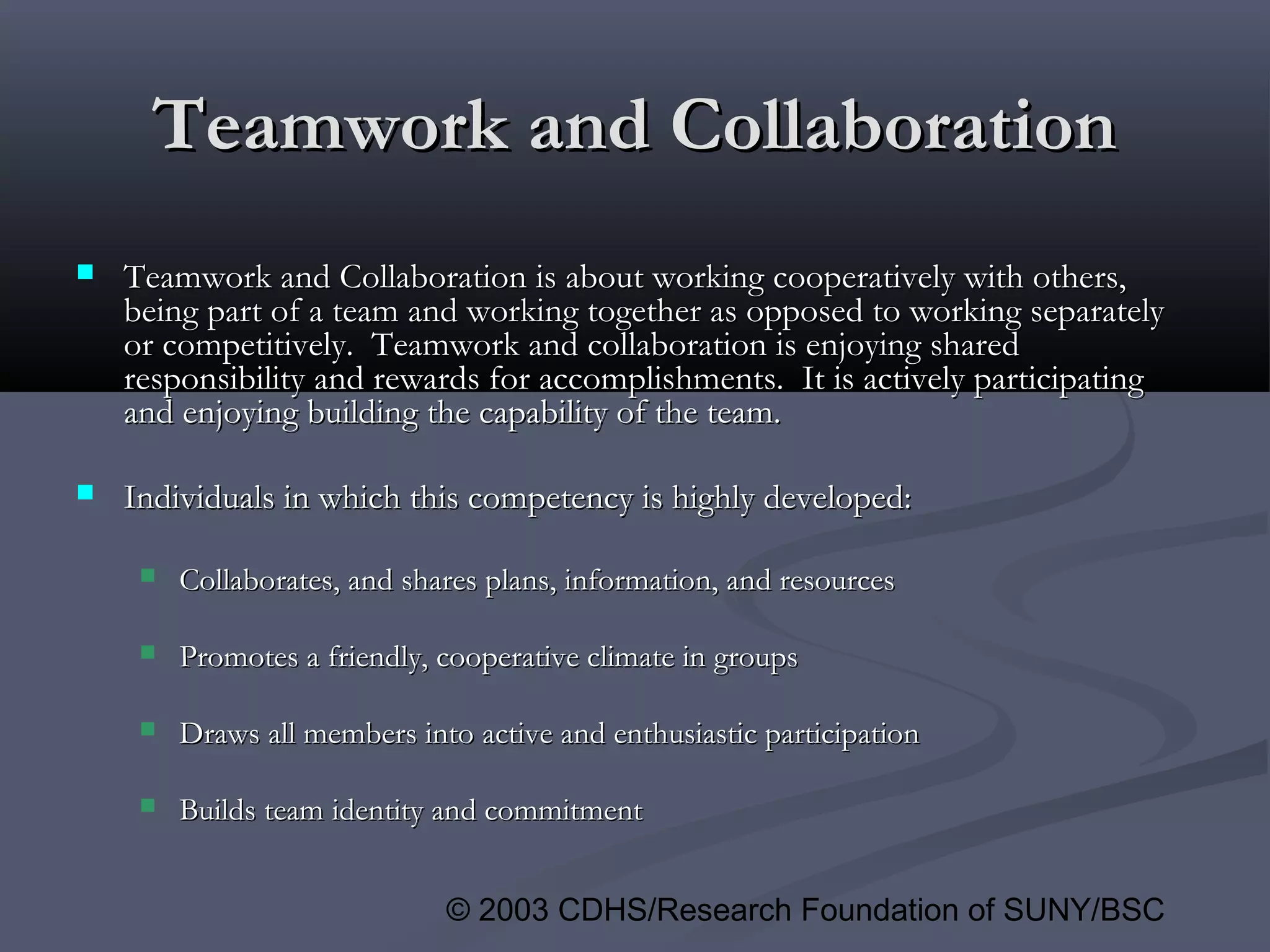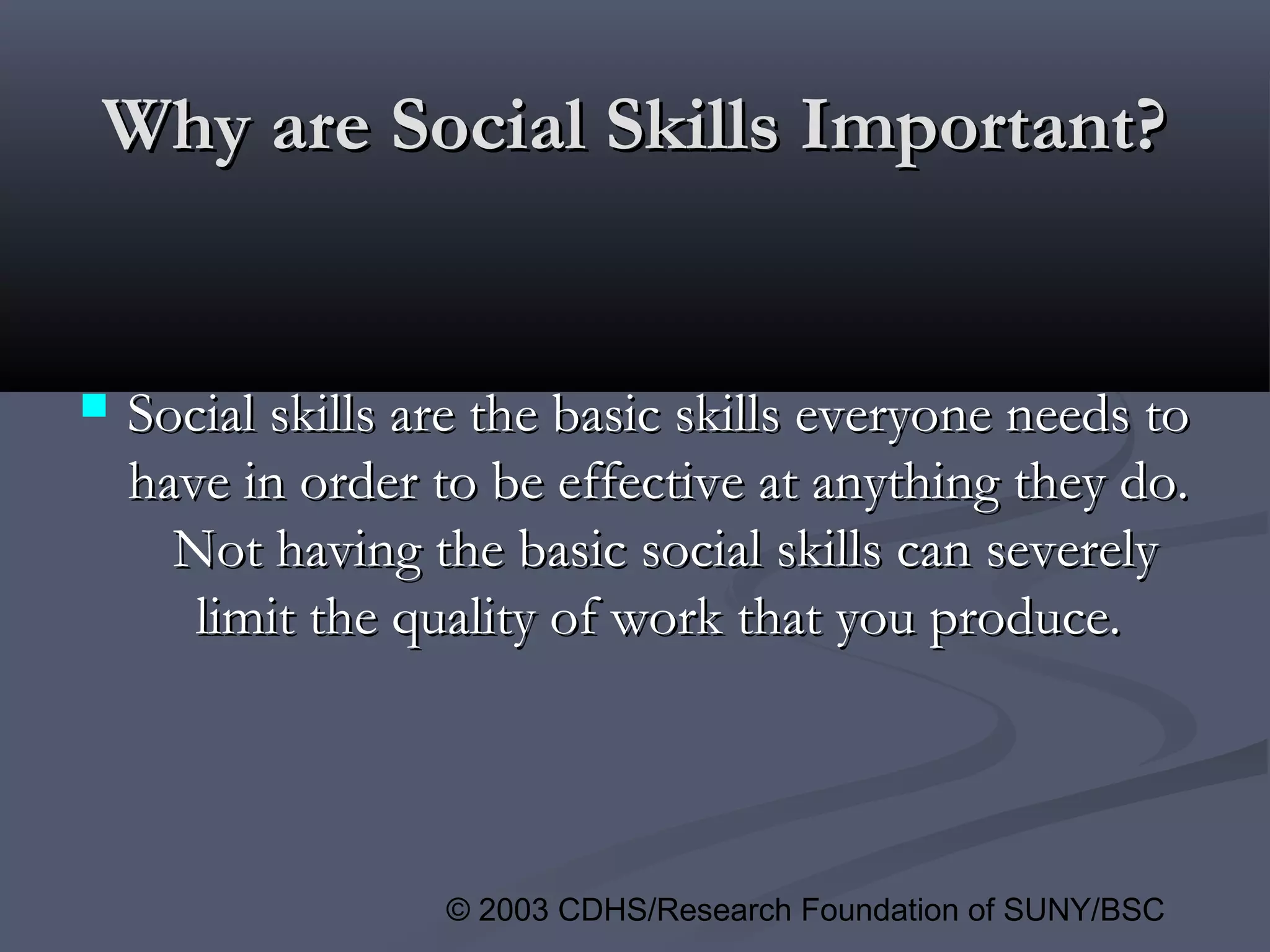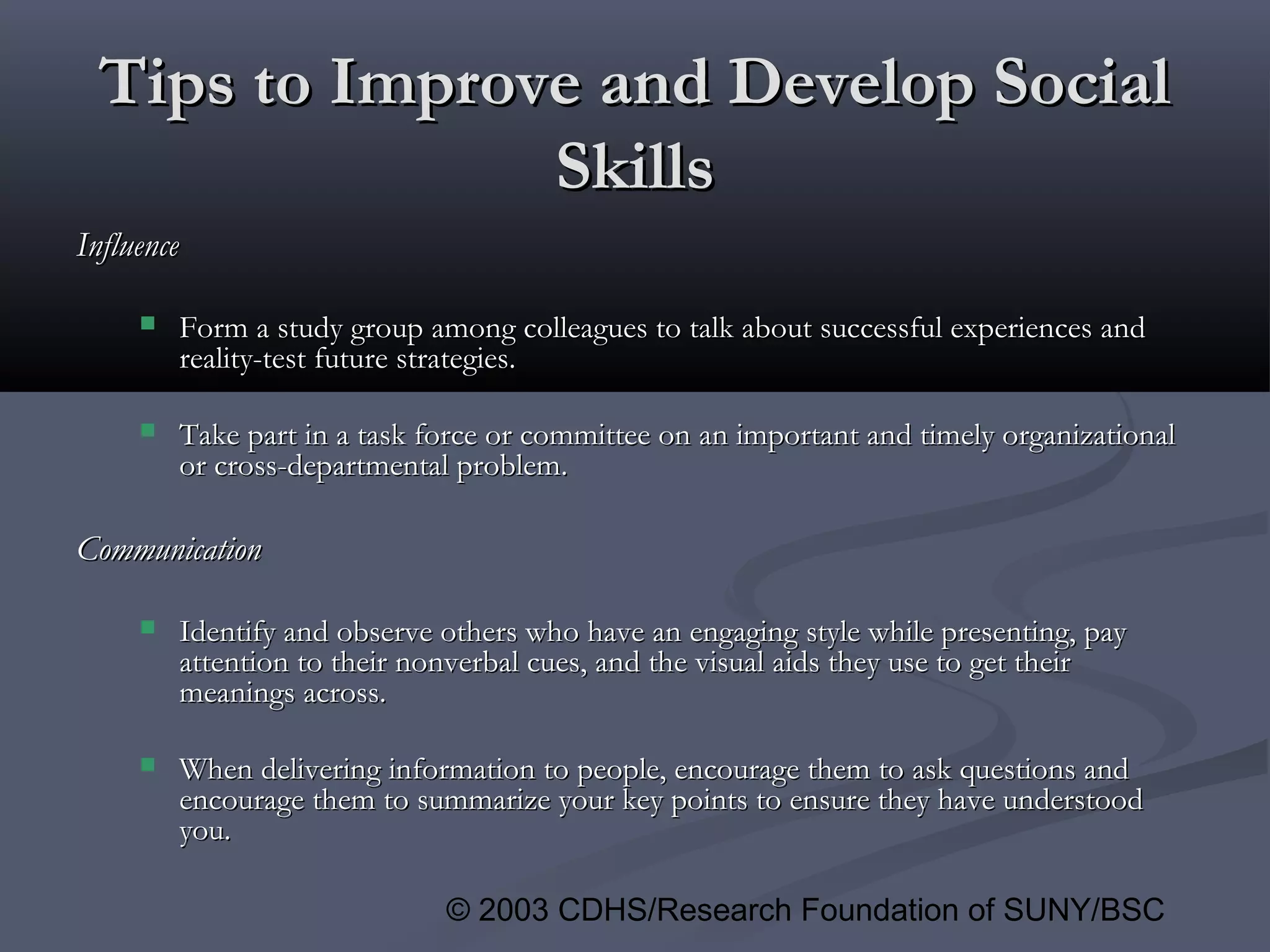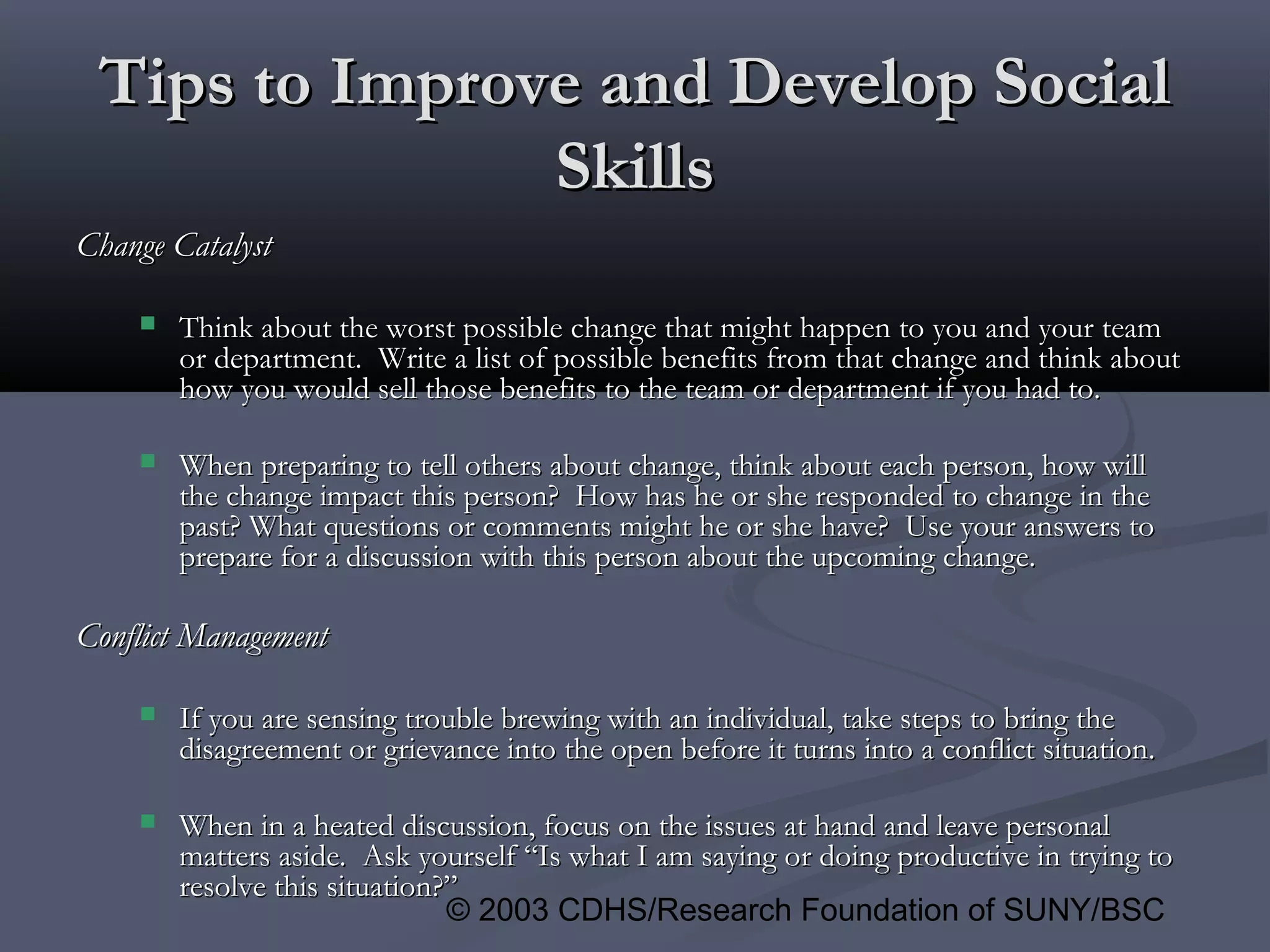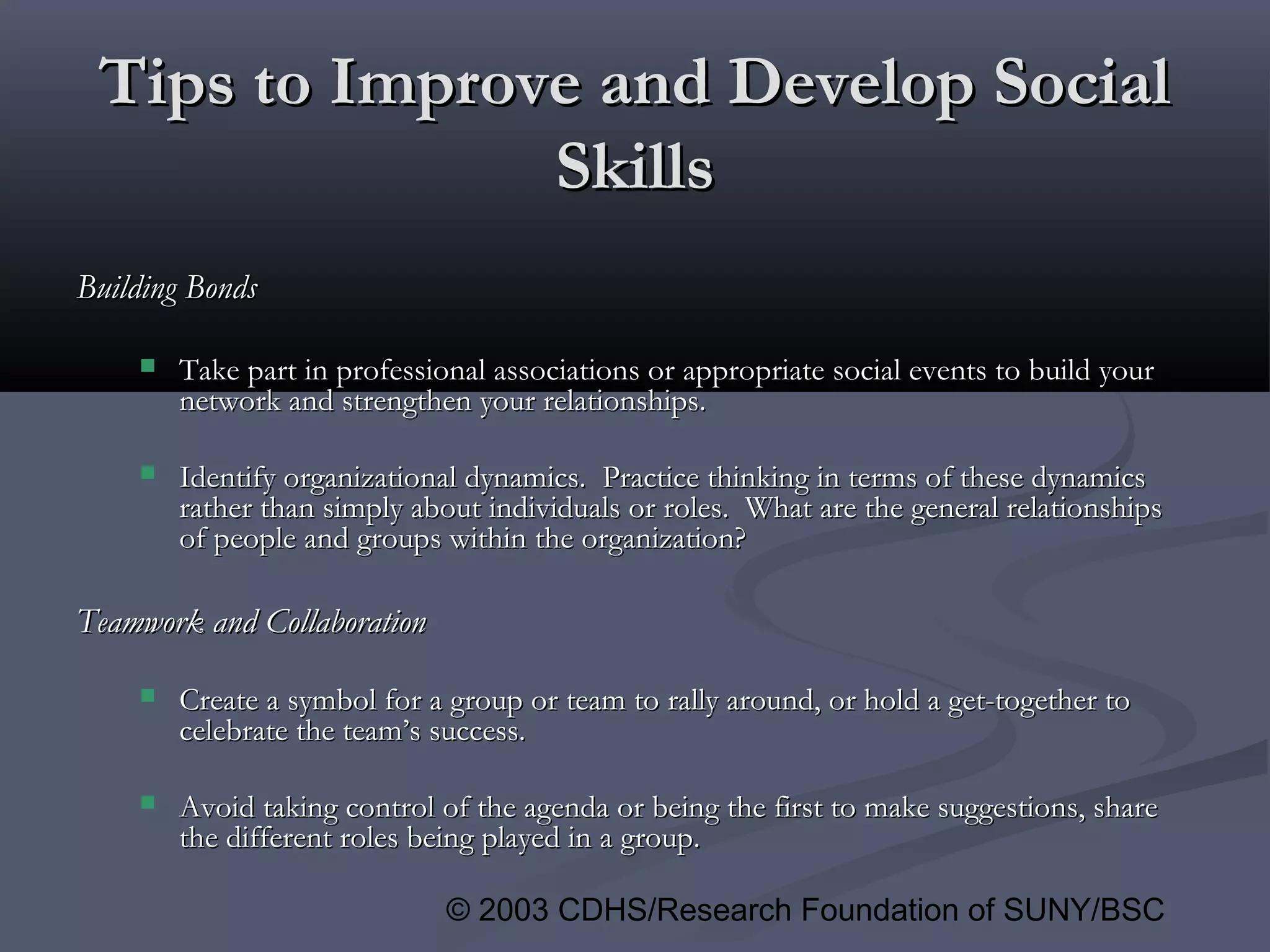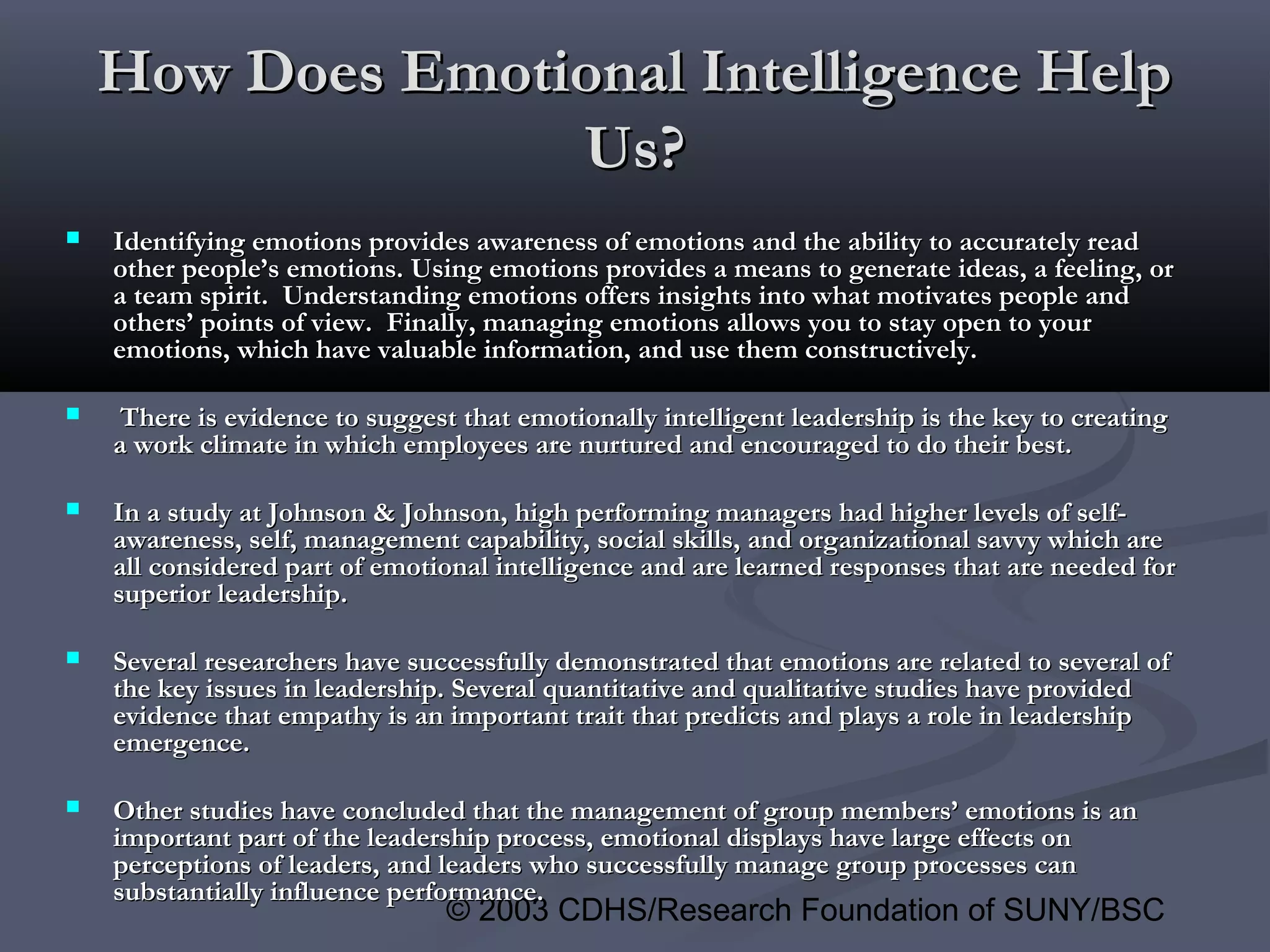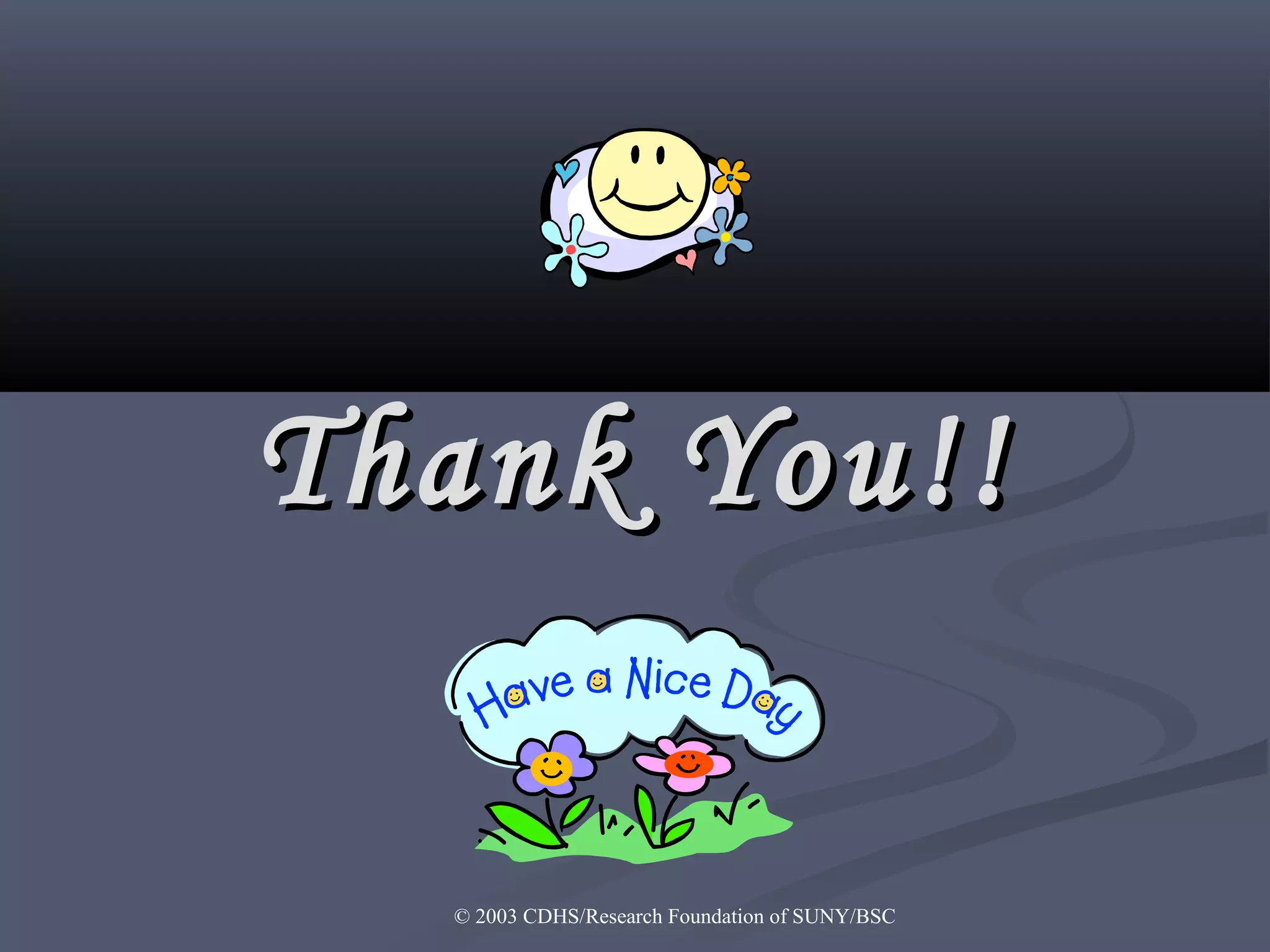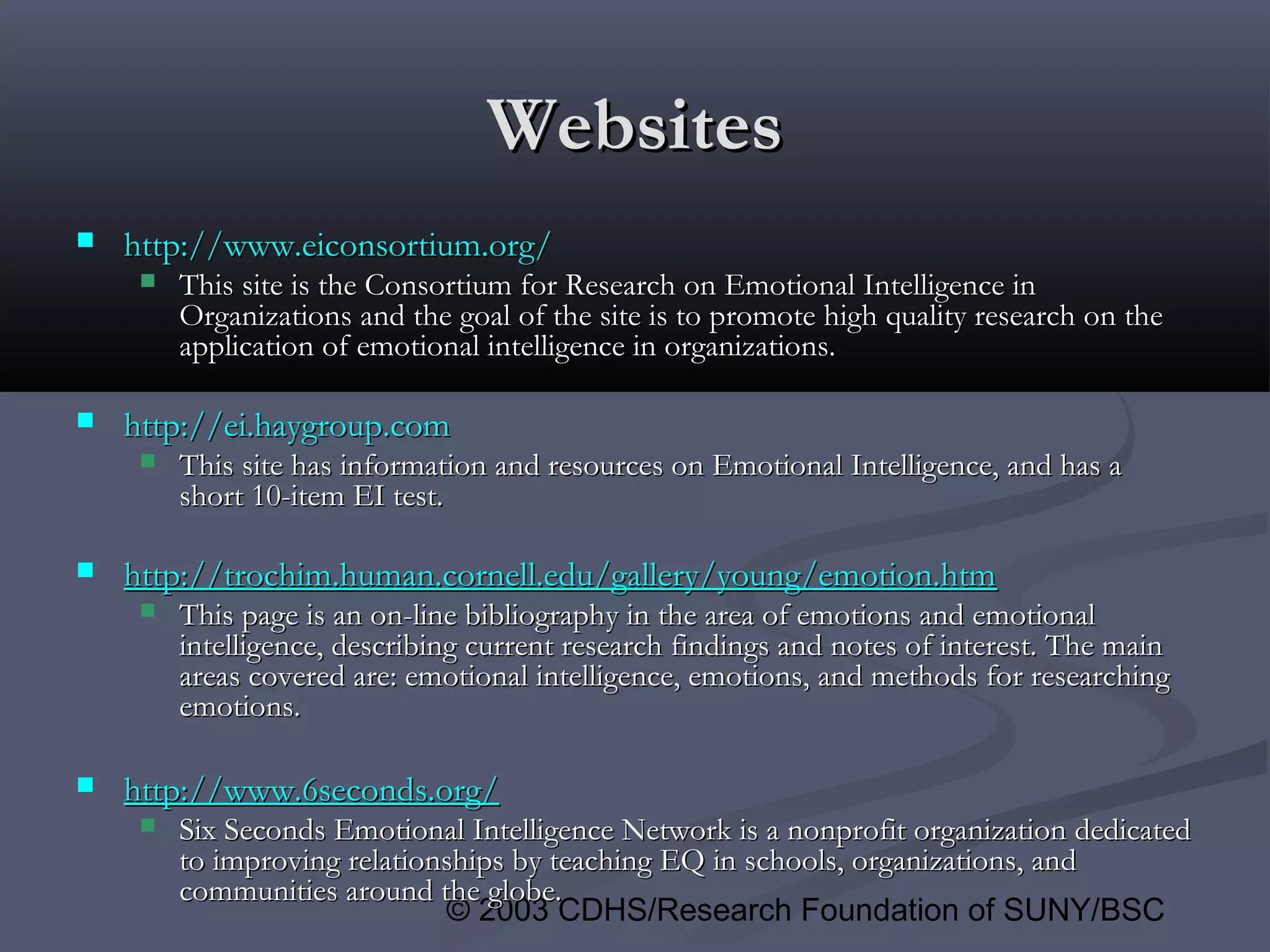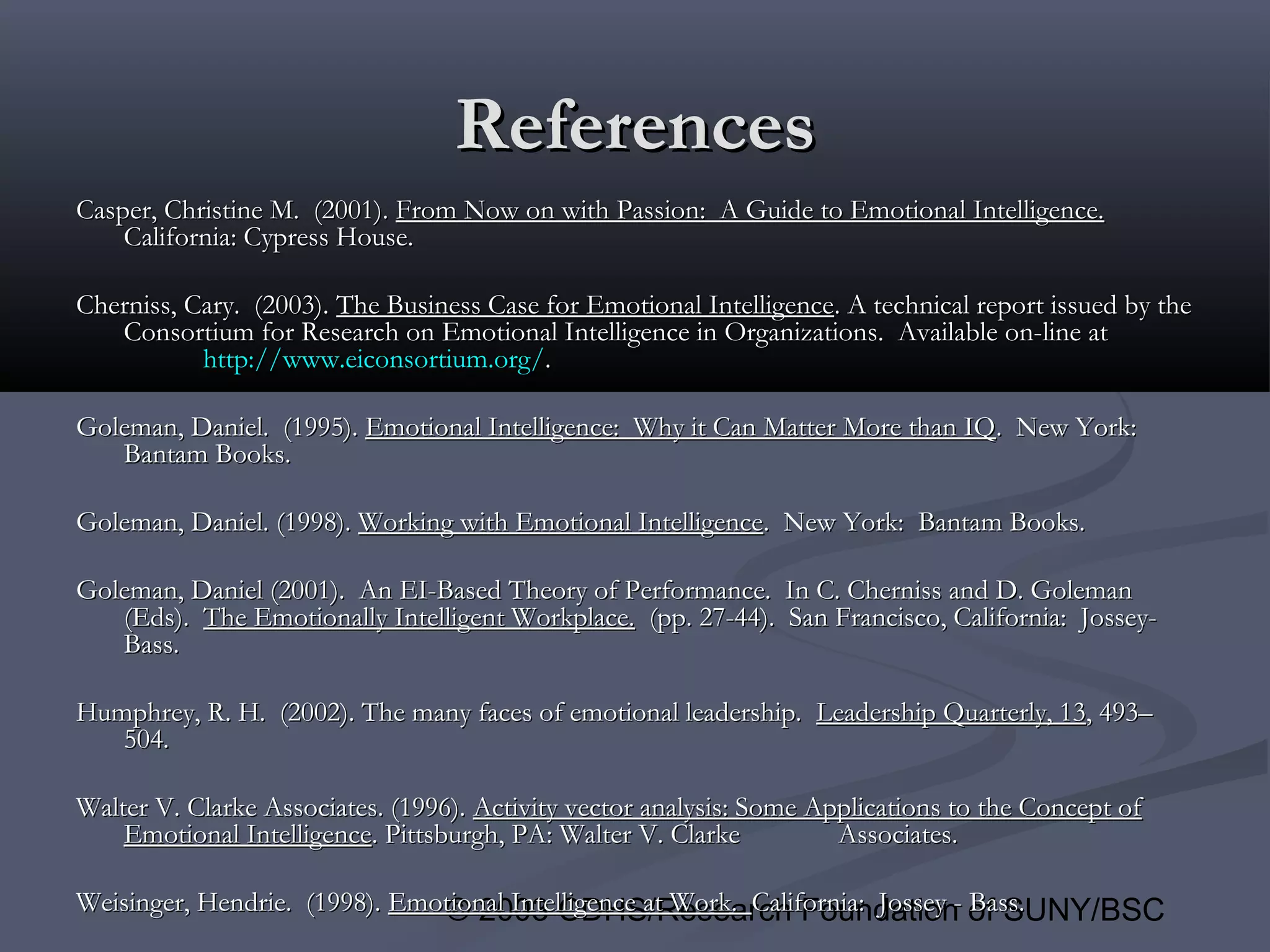The document discusses emotional intelligence and how it influences people's lives at work and at home. It defines emotional intelligence as the capacity to understand one's own and others' feelings, motivate oneself, and manage emotions effectively. Rather than a single trait, emotional intelligence involves four clusters of competencies: self-awareness, self-management, social awareness, and social skills. The document provides a short questionnaire to assess one's own emotional intelligence in different situations and scores possible responses. It suggests emotional intelligence helps people at home and work through competencies organized in the four clusters.
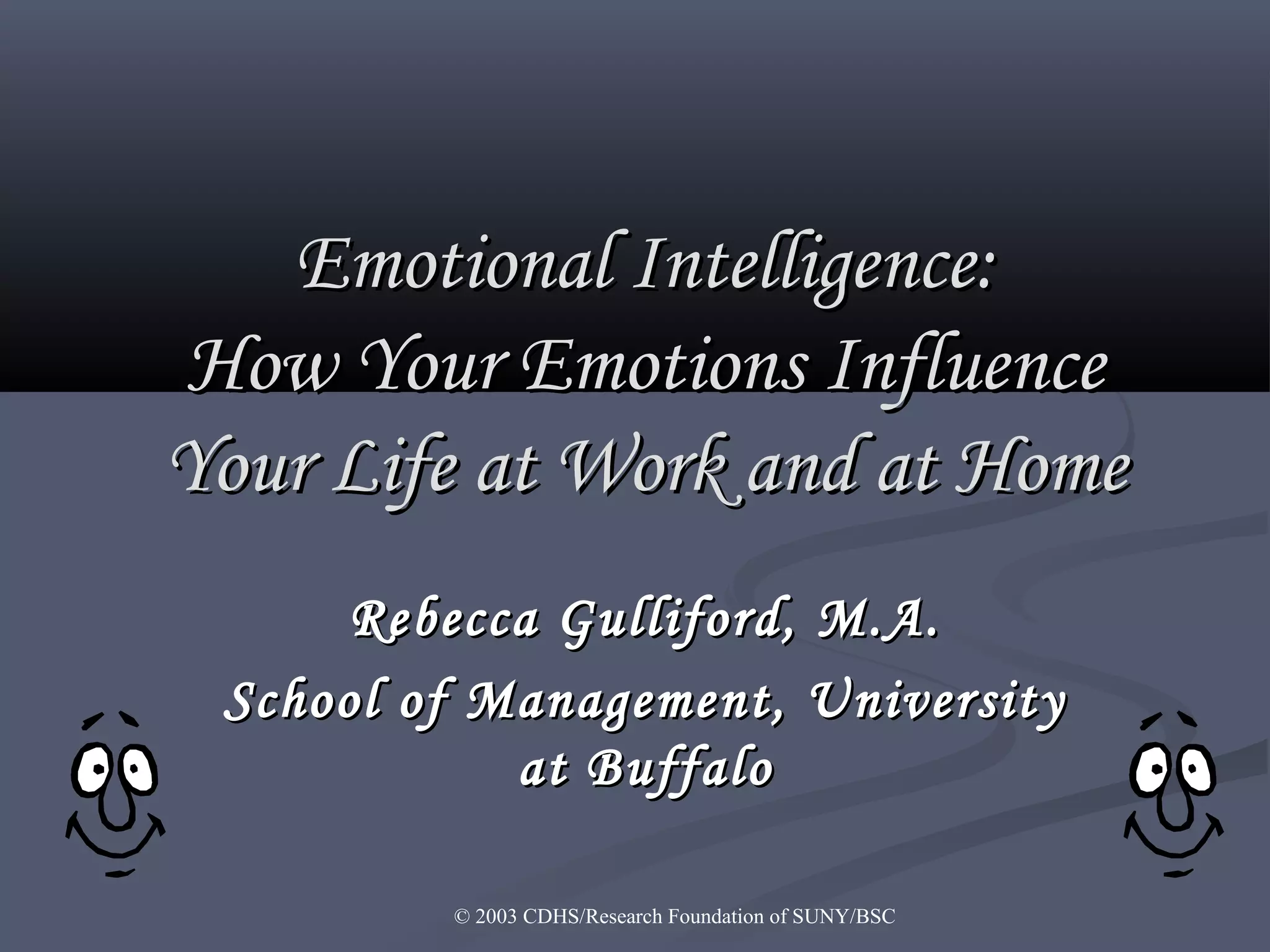
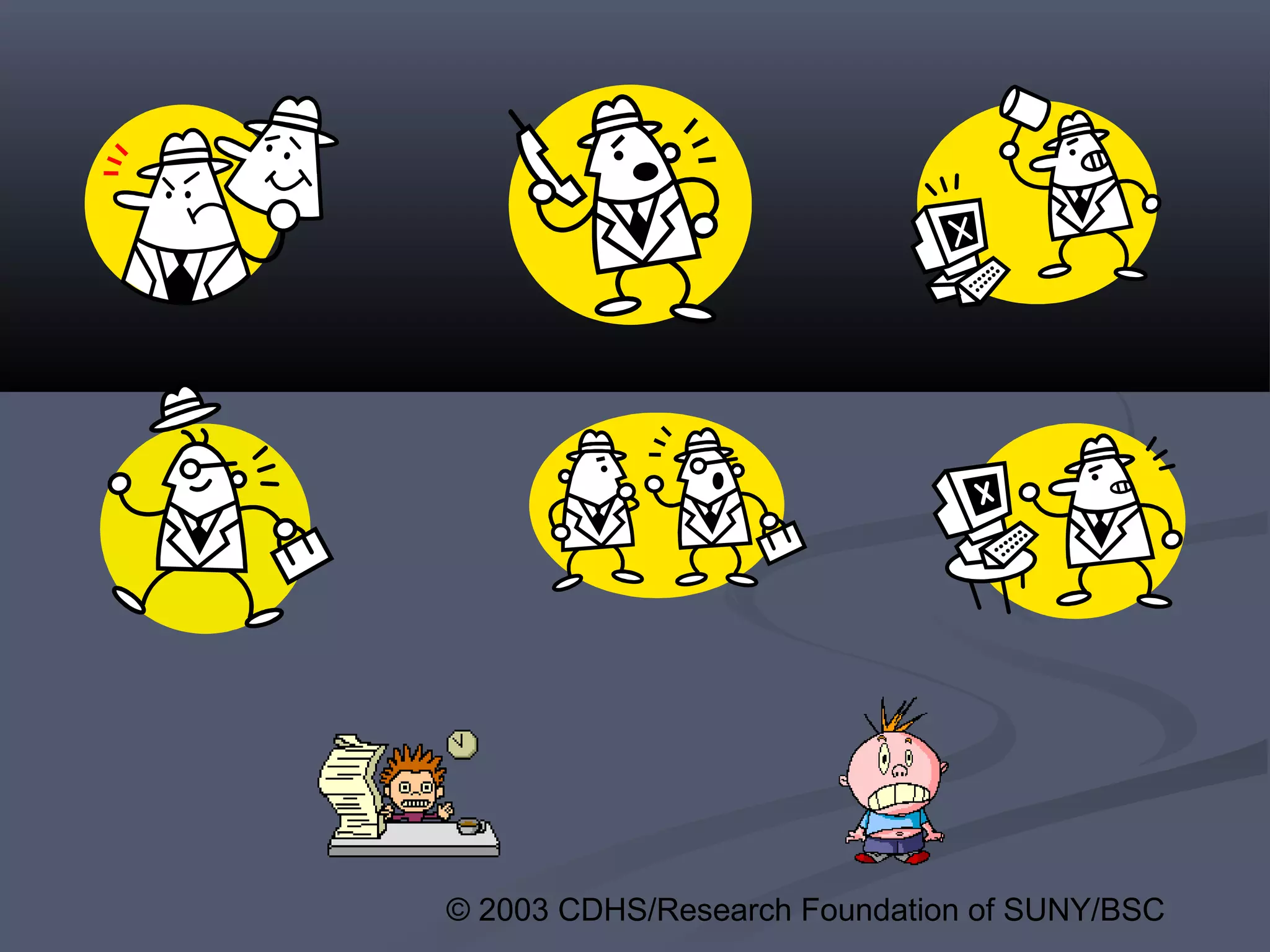
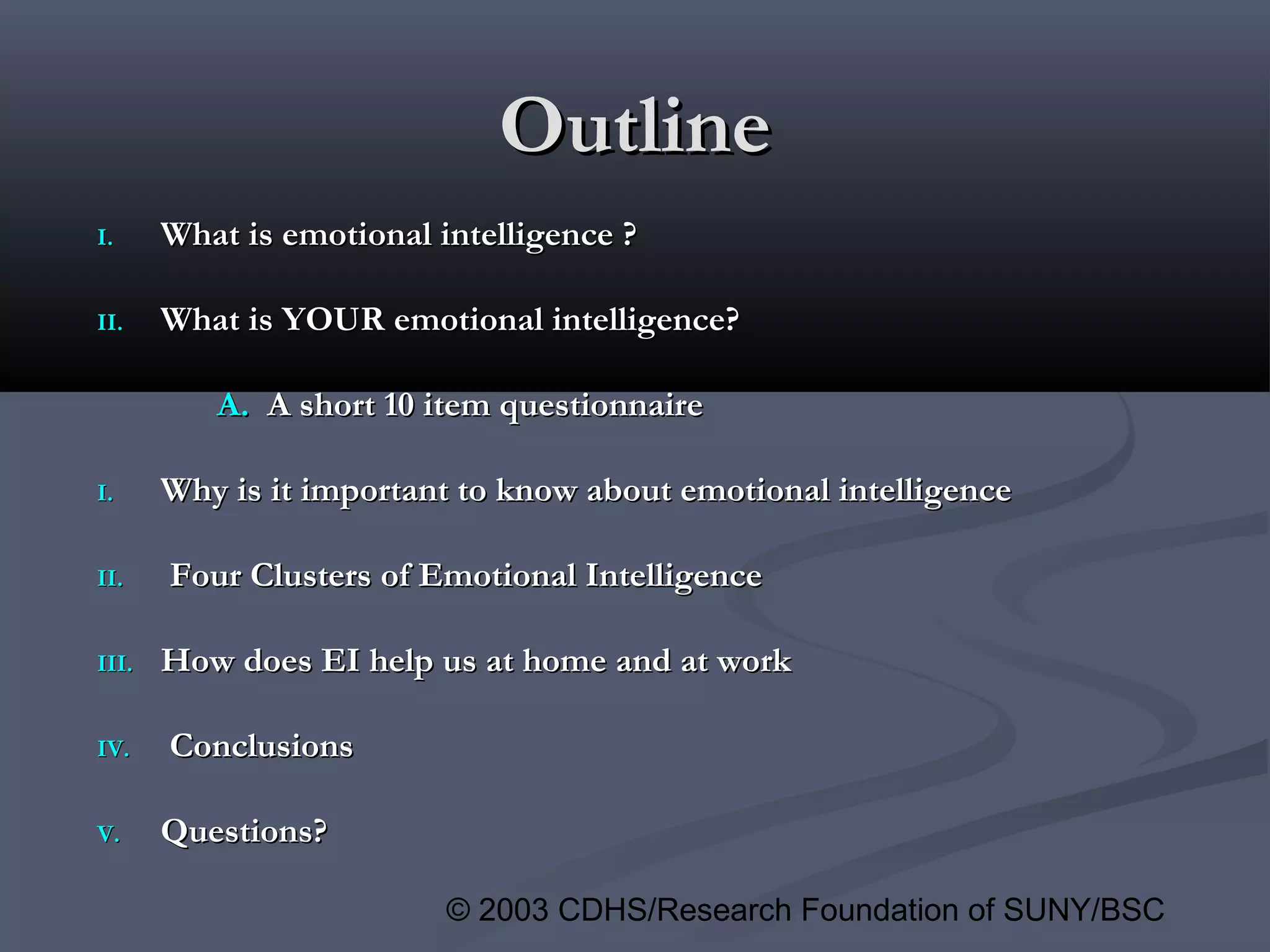
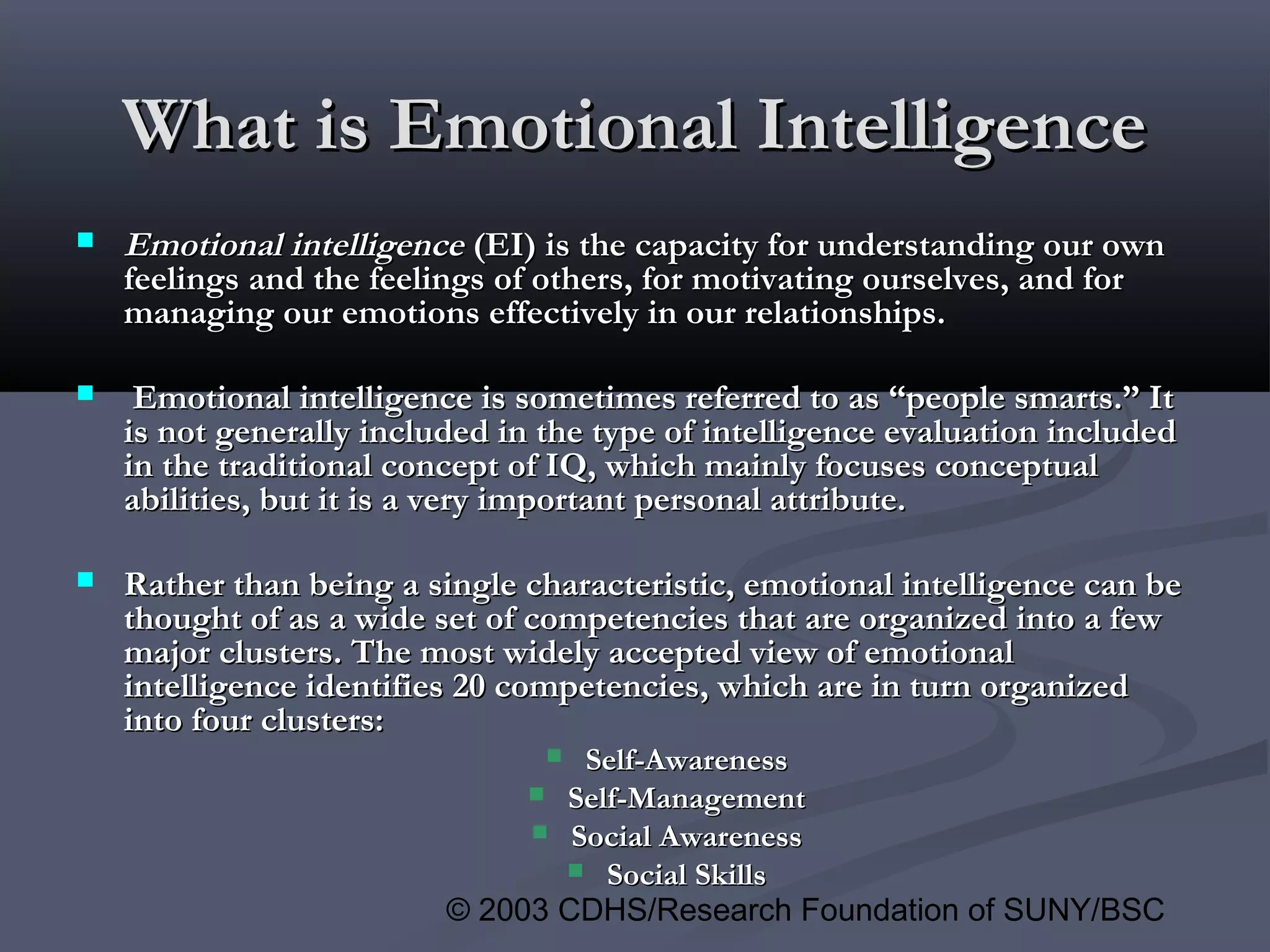

![© 2003 CDHS/Research Foundation of SUNY/BSC
Write down the number of points you get for the answer you wrote down, then addWrite down the number of points you get for the answer you wrote down, then add
them all up.them all up.
The turbulent airplane:The turbulent airplane:
Anything but D - that answer reflects a lack of awareness of your habitual responsesAnything but D - that answer reflects a lack of awareness of your habitual responses
under stress. Actively acknowledging your stress and finding ways to calm yourself (i.e.under stress. Actively acknowledging your stress and finding ways to calm yourself (i.e.
engage in a book or read the emergency card) are healthier responses.engage in a book or read the emergency card) are healthier responses.
[A] 10 Points - Continue to read your book or magazine, or watch the movie,[A] 10 Points - Continue to read your book or magazine, or watch the movie,
trying to pay little attention to the turbulence.trying to pay little attention to the turbulence.
[B] 10 Points - Become vigilant for an emergency, carefully monitoring the[B] 10 Points - Become vigilant for an emergency, carefully monitoring the
stewardesses and reading the emergency instructions card.stewardesses and reading the emergency instructions card.
[C] 10 Points - A little of both A and B.[C] 10 Points - A little of both A and B.
[D] 0 Points - Not sure - never noticed.[D] 0 Points - Not sure - never noticed.
Scoring your AnswersScoring your Answers](https://image.slidesharecdn.com/emotionalintelligencepresentationppt-151217222433/75/Emotional-intelligence-presentation-ppt-6-2048.jpg)
![© 2003 CDHS/Research Foundation of SUNY/BSC
Scoring your AnswersScoring your Answers
2. The credit stealing colleague:2. The credit stealing colleague:
The most emotionally intelligent answer is D. By demonstrating an awareness of work-The most emotionally intelligent answer is D. By demonstrating an awareness of work-
place dynamics, and an ability to control your emotional responses, publicly recognizingplace dynamics, and an ability to control your emotional responses, publicly recognizing
your own accomplishments in a non-threatening manner will disarm your colleague asyour own accomplishments in a non-threatening manner will disarm your colleague as
well as puts you in a better light with your manager and peers. Public confrontations canwell as puts you in a better light with your manager and peers. Public confrontations can
be ineffective, are likely to cause your colleague to become defensive, and may look likebe ineffective, are likely to cause your colleague to become defensive, and may look like
poor sportsmanship on your part. Although less threatening, private confrontations arepoor sportsmanship on your part. Although less threatening, private confrontations are
also less effective in that they will not help your personal reputation.also less effective in that they will not help your personal reputation.
[A] 0 Points - Immediately and publicly confront the colleague over the[A] 0 Points - Immediately and publicly confront the colleague over the ownershipownership
of your work.of your work.
[B] 5 Points - After the meeting, take the colleague aside and tell her that[B] 5 Points - After the meeting, take the colleague aside and tell her that
you would appreciate in the future that she credits you when speaking about youryou would appreciate in the future that she credits you when speaking about your
work.work.
[C] 0 Points - Nothing, it's not a good idea to embarrass colleagues in public.[C] 0 Points - Nothing, it's not a good idea to embarrass colleagues in public.
[D] 10 Points - After the colleague speaks, publicly thank her for referencing your[D] 10 Points - After the colleague speaks, publicly thank her for referencing your
work and give the group more specific detail about what you were trying towork and give the group more specific detail about what you were trying to
accomplish.accomplish.](https://image.slidesharecdn.com/emotionalintelligencepresentationppt-151217222433/75/Emotional-intelligence-presentation-ppt-7-2048.jpg)
![© 2003 CDHS/Research Foundation of SUNY/BSC
3. The angry client:3. The angry client:
The most emotionally intelligent answer is D. Empathizing with the customer will helpThe most emotionally intelligent answer is D. Empathizing with the customer will help
calm him down and focusing back on a solution will ultimately help the customer attain hiscalm him down and focusing back on a solution will ultimately help the customer attain his
needs. Confronting a customer or becoming defensive tends to anger the customer evenneeds. Confronting a customer or becoming defensive tends to anger the customer even
more.more.
[A] 0 Points - Hang-up. It doesn't pay to take abuse from anyone.[A] 0 Points - Hang-up. It doesn't pay to take abuse from anyone.
[B] 5 Points - Listen to the client and rephrase what you gather he is feeling.[B] 5 Points - Listen to the client and rephrase what you gather he is feeling.
[C] 0 Points - Explain to the client that he is being unfair, that you are only trying to[C] 0 Points - Explain to the client that he is being unfair, that you are only trying to
do your job, and you would appreciate it if he wouldn't get in the way of this.do your job, and you would appreciate it if he wouldn't get in the way of this.
[D] 10 Points - Tell the client you understand how frustrating this must be for him,[D] 10 Points - Tell the client you understand how frustrating this must be for him,
and offer a specific thing you can do to help him get his problem resolved.and offer a specific thing you can do to help him get his problem resolved.
Scoring your AnswersScoring your Answers](https://image.slidesharecdn.com/emotionalintelligencepresentationppt-151217222433/75/Emotional-intelligence-presentation-ppt-8-2048.jpg)
![© 2003 CDHS/Research Foundation of SUNY/BSC
Scoring your AnswersScoring your Answers
4. The 'C' Midterm:4. The 'C' Midterm:
The most emotionally intelligent answer is A. A key indicator of self-motivation, alsoThe most emotionally intelligent answer is A. A key indicator of self-motivation, also
known as achievement motivation, is your ability to form a plan for overcoming obstaclesknown as achievement motivation, is your ability to form a plan for overcoming obstacles
to achieve long-term goals. While focusing efforts on classes where you have a betterto achieve long-term goals. While focusing efforts on classes where you have a better
opportunity may sometimes be productive, if the goal was to learn the content of the courseopportunity may sometimes be productive, if the goal was to learn the content of the course
to help your long-term career objectives, you are unlikely to achieve.to help your long-term career objectives, you are unlikely to achieve.
[A] 10 Points - Sketch out a specific plan for ways to improve your grade and resolve[A] 10 Points - Sketch out a specific plan for ways to improve your grade and resolve
to follow through.to follow through.
[B] 0 Points - Decide you do not have what it takes to make it in that career.[B] 0 Points - Decide you do not have what it takes to make it in that career.
[C] 5 Points - Tell yourself it really doesn't matter how much you do in the[C] 5 Points - Tell yourself it really doesn't matter how much you do in the
course, concentrate instead on other classes where your grades are higher.course, concentrate instead on other classes where your grades are higher.
[D] 0 Points - Go see the professor and try to talk her into giving you a[D] 0 Points - Go see the professor and try to talk her into giving you a better gradebetter grade](https://image.slidesharecdn.com/emotionalintelligencepresentationppt-151217222433/75/Emotional-intelligence-presentation-ppt-9-2048.jpg)
![© 2003 CDHS/Research Foundation of SUNY/BSC
Scoring your AnswersScoring your Answers
5. The racist joke:5. The racist joke:
The most emotionally intelligent answer is C. The most effective way to create anThe most emotionally intelligent answer is C. The most effective way to create an
atmosphere that welcomes diversity is to make clear in public that the social norms of youratmosphere that welcomes diversity is to make clear in public that the social norms of your
organization do not tolerate such expressions. Confronting the behavior privately lets theorganization do not tolerate such expressions. Confronting the behavior privately lets the
individual know the behavior is unacceptable, but does not communicate it to the team.individual know the behavior is unacceptable, but does not communicate it to the team.
Instead of trying to change prejudices (a much harder task), keep people from acting onInstead of trying to change prejudices (a much harder task), keep people from acting on
them.them.
[A] 0 Points - Ignore it - the best way to deal with these things is not to[A] 0 Points - Ignore it - the best way to deal with these things is not to react.react.
[B] 5 Points - Call the person into your office and explain that their behavior is[B] 5 Points - Call the person into your office and explain that their behavior is
inappropriate and is grounds for disciplinary action if repeated.inappropriate and is grounds for disciplinary action if repeated.
[C] 10 Points - Speak up on the spot, saying that such jokes are[C] 10 Points - Speak up on the spot, saying that such jokes are
inappropriate and will not be tolerated in your organization.inappropriate and will not be tolerated in your organization.
[D] 5 Points - Suggest to the person telling the joke he go through a diversity[D] 5 Points - Suggest to the person telling the joke he go through a diversity
training program.training program.](https://image.slidesharecdn.com/emotionalintelligencepresentationppt-151217222433/75/Emotional-intelligence-presentation-ppt-10-2048.jpg)
![© 2003 CDHS/Research Foundation of SUNY/BSC
Scoring your AnswersScoring your Answers
6. The setback of a salesman:6. The setback of a salesman:
The most emotionally intelligent answer is B. Optimism and taking the initiative, bothThe most emotionally intelligent answer is B. Optimism and taking the initiative, both
indicators of emotional intelligence, lead people to see setbacks as challenges they can learnindicators of emotional intelligence, lead people to see setbacks as challenges they can learn
from, and to persist, trying out new approaches rather than giving up, blaming themselvesfrom, and to persist, trying out new approaches rather than giving up, blaming themselves
or getting demoralized.or getting demoralized.
[A] 0 Points - Call it a day and go home early to miss rush-hour traffic.[A] 0 Points - Call it a day and go home early to miss rush-hour traffic.
[B] 10 Points - Try something new in the next call, and keep plugging away.[B] 10 Points - Try something new in the next call, and keep plugging away.
[C] 5 Points - List your strengths and weaknesses to identify what may be[C] 5 Points - List your strengths and weaknesses to identify what may be
undermining your ability to sell.undermining your ability to sell.
[D] 0 Points - Sharpen up your resume.[D] 0 Points - Sharpen up your resume.](https://image.slidesharecdn.com/emotionalintelligencepresentationppt-151217222433/75/Emotional-intelligence-presentation-ppt-11-2048.jpg)
![© 2003 CDHS/Research Foundation of SUNY/BSC
Scoring your AnswersScoring your Answers
7. The Road-Rage colleague:7. The Road-Rage colleague:
The most emotionally intelligent answer is D. All research shows that anger and rageThe most emotionally intelligent answer is D. All research shows that anger and rage
seriously affect one's ability to perform effectively. Your ability to avoid or control thisseriously affect one's ability to perform effectively. Your ability to avoid or control this
emotional reaction in yourself and others is a key indicator of emotional intelligence.emotional reaction in yourself and others is a key indicator of emotional intelligence.
[A] 0 Points - Tell her to forget about it-she's OK now and it is no big[A] 0 Points - Tell her to forget about it-she's OK now and it is no big deal.deal.
[B] 0 Points - Put on one of her favorite tapes and try to distract her.[B] 0 Points - Put on one of her favorite tapes and try to distract her.
[C] 5 Points - Join her in criticizing the other driver.[C] 5 Points - Join her in criticizing the other driver.
[D] 10 Points - Tell her about a time something like this happened to you, and[D] 10 Points - Tell her about a time something like this happened to you, and
how angry you felt, until you saw the other driver was on thehow angry you felt, until you saw the other driver was on the way to theway to the
hospital.hospital.](https://image.slidesharecdn.com/emotionalintelligencepresentationppt-151217222433/75/Emotional-intelligence-presentation-ppt-12-2048.jpg)
![© 2003 CDHS/Research Foundation of SUNY/BSC
Scoring your AnswersScoring your Answers
8. The shouting match:8. The shouting match:
The most emotionally intelligent answer is A. In these circumstances, the most appropriateThe most emotionally intelligent answer is A. In these circumstances, the most appropriate
behavior is to take a 20-minute break. As the argument has intensified, so have thebehavior is to take a 20-minute break. As the argument has intensified, so have the
physiological responses in your nervous system, to the point at which it will take at least 20physiological responses in your nervous system, to the point at which it will take at least 20
minutes to clear your body of these emotions of anger and arousal. Any other course ofminutes to clear your body of these emotions of anger and arousal. Any other course of
action is likely merely to aggravate an already tense and uncontrolled situation.action is likely merely to aggravate an already tense and uncontrolled situation.
[A] 10 Points - Agree to take a 20-minute break before continuing the discussion.[A] 10 Points - Agree to take a 20-minute break before continuing the discussion.
[B] 0 Points - Go silent, regardless of what your partner says.[B] 0 Points - Go silent, regardless of what your partner says.
[C] 0 Points - Say you are sorry, and ask your partner to apologize too.[C] 0 Points - Say you are sorry, and ask your partner to apologize too.
[D] 0 Points - Stop for a moment, collect your thoughts, then restate your[D] 0 Points - Stop for a moment, collect your thoughts, then restate your
side of the case as precisely as possible.side of the case as precisely as possible.](https://image.slidesharecdn.com/emotionalintelligencepresentationppt-151217222433/75/Emotional-intelligence-presentation-ppt-13-2048.jpg)
![© 2003 CDHS/Research Foundation of SUNY/BSC
Scoring your AnswersScoring your Answers
99. The uninspired team:. The uninspired team:
The most emotionally intelligent answer is B. As a leader of a group of individuals chargedThe most emotionally intelligent answer is B. As a leader of a group of individuals charged
with developing a creative solution, your success will depend on the climate that you canwith developing a creative solution, your success will depend on the climate that you can
create in your project team. Creativity is likely to by stifled by structure and formality;create in your project team. Creativity is likely to by stifled by structure and formality;
instead, creative groups perform at their peaks when rapport, harmony and comfort levelsinstead, creative groups perform at their peaks when rapport, harmony and comfort levels
are most high. In these circumstances, people are most likely to make the most positiveare most high. In these circumstances, people are most likely to make the most positive
contributions to the success of the project.contributions to the success of the project.
[A] 0 Points - Draw up an agenda, call a meeting and allot a specific period of time[A] 0 Points - Draw up an agenda, call a meeting and allot a specific period of time
to discuss each item.to discuss each item.
[B] 10 Points - Organize an off-site meeting aimed specifically at encouraging the[B] 10 Points - Organize an off-site meeting aimed specifically at encouraging the
team to get to know each other better.team to get to know each other better.
[C] 0 Points - Begin by asking each person individually for ideas about how to solve[C] 0 Points - Begin by asking each person individually for ideas about how to solve
the problem.the problem.
[D] 5 Points - Start out with a brainstorming session, encouraging each[D] 5 Points - Start out with a brainstorming session, encouraging each person toperson to
say whatever comes to mind, no matter how wild.say whatever comes to mind, no matter how wild.](https://image.slidesharecdn.com/emotionalintelligencepresentationppt-151217222433/75/Emotional-intelligence-presentation-ppt-14-2048.jpg)
![© 2003 CDHS/Research Foundation of SUNY/BSC
Scoring your AnswersScoring your Answers
10. The indecisive young manager:10. The indecisive young manager:
The most emotionally intelligent answer is D. Managing others requires high levels ofThe most emotionally intelligent answer is D. Managing others requires high levels of
emotional intelligence, particularly if you are going to be successful in maximizing theemotional intelligence, particularly if you are going to be successful in maximizing the
performance of your team. Often, this means that you need to tailor your approach toperformance of your team. Often, this means that you need to tailor your approach to
meets the specific needs of the individual, and provide them with support and feedback tomeets the specific needs of the individual, and provide them with support and feedback to
help them grow in confidence and capability.help them grow in confidence and capability.
[A] 0 Points - Accept that he 'does not have what it take to succeed around[A] 0 Points - Accept that he 'does not have what it take to succeed around
here' and find others in your team to take on his tasks.here' and find others in your team to take on his tasks.
[B] 5 Points - Get an HR manager to talk to him about where he sees his[B] 5 Points - Get an HR manager to talk to him about where he sees his
future in the organization.future in the organization.
[C] 0 Points - Purposely give him lots of complex decisions to make so that he will[C] 0 Points - Purposely give him lots of complex decisions to make so that he will
become more confident in the role.become more confident in the role.
[D] 10 Points - Engineer an ongoing series of challenging but manageable[D] 10 Points - Engineer an ongoing series of challenging but manageable
experiences for him, and make yourself available to act as his mentor.experiences for him, and make yourself available to act as his mentor.](https://image.slidesharecdn.com/emotionalintelligencepresentationppt-151217222433/75/Emotional-intelligence-presentation-ppt-15-2048.jpg)
